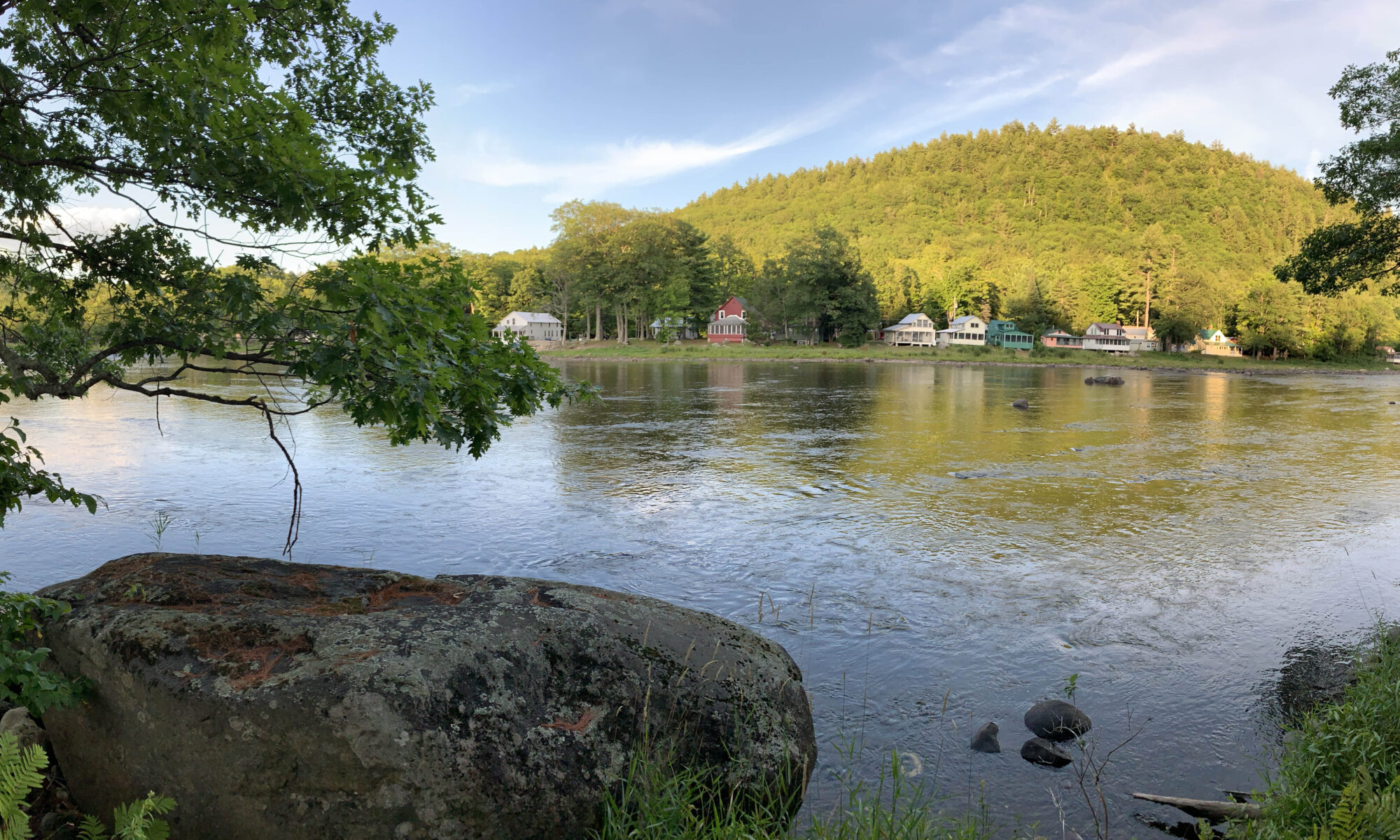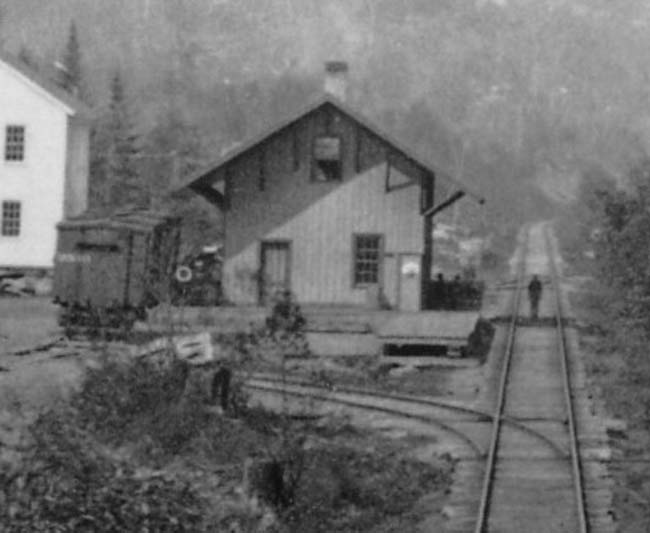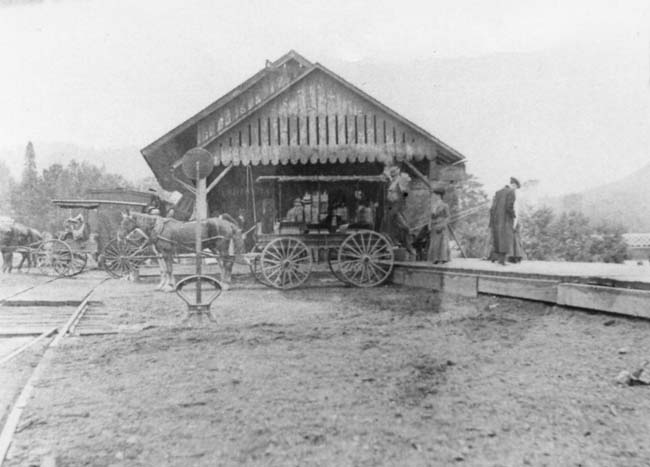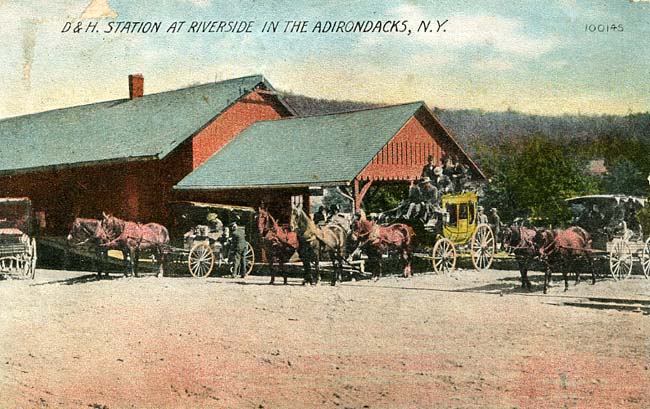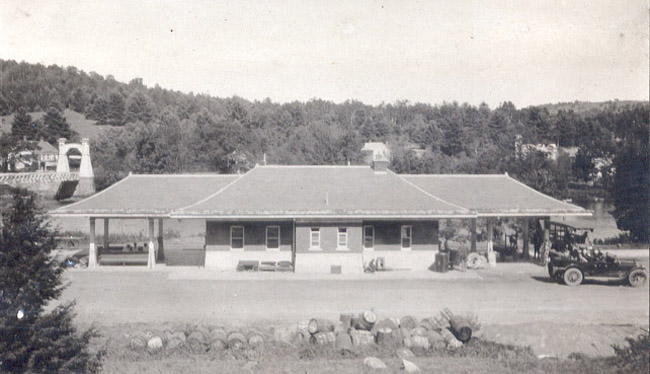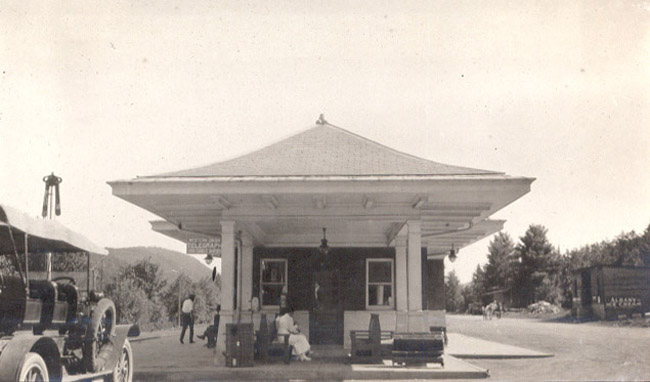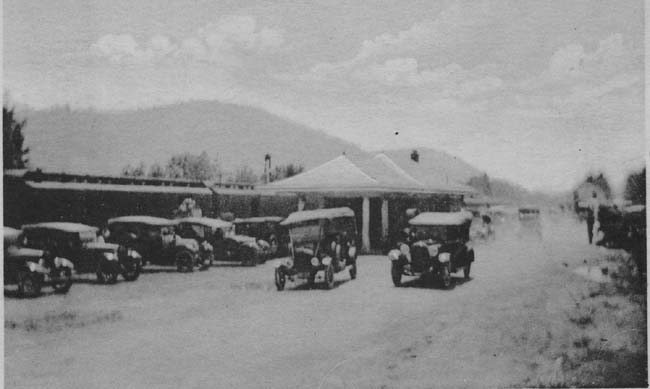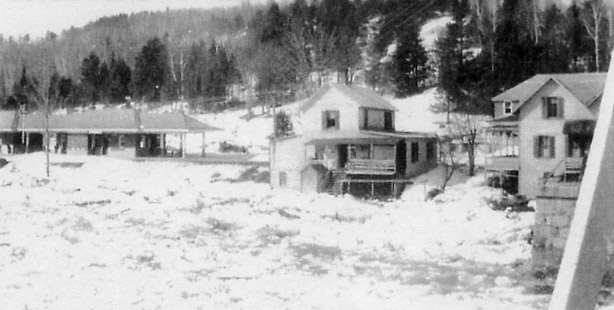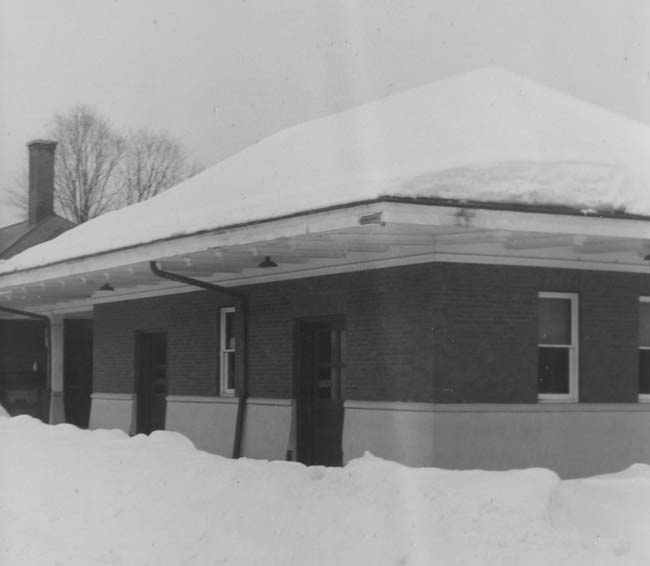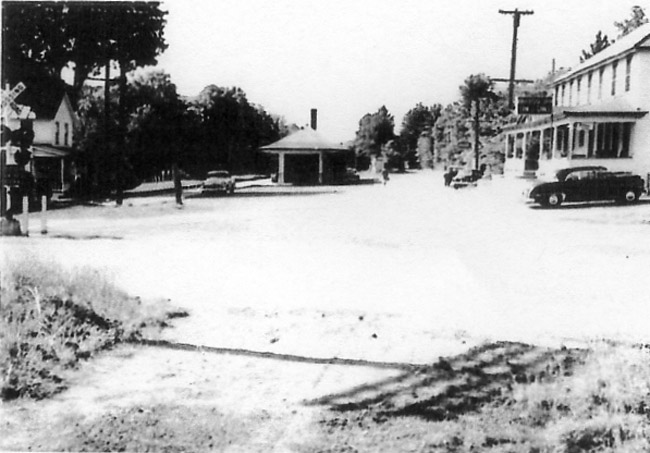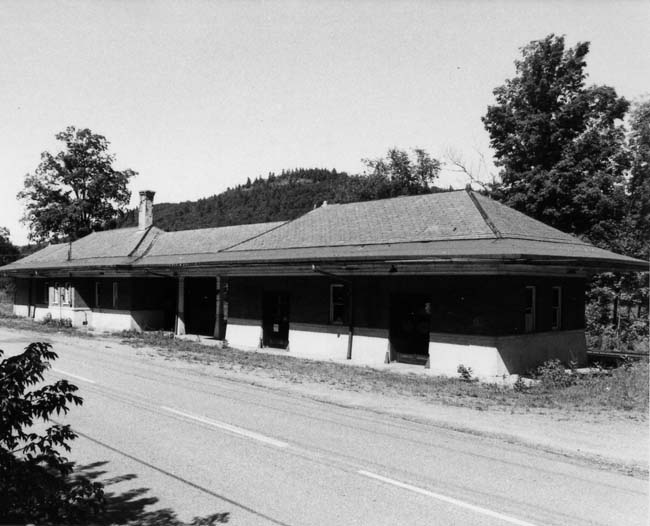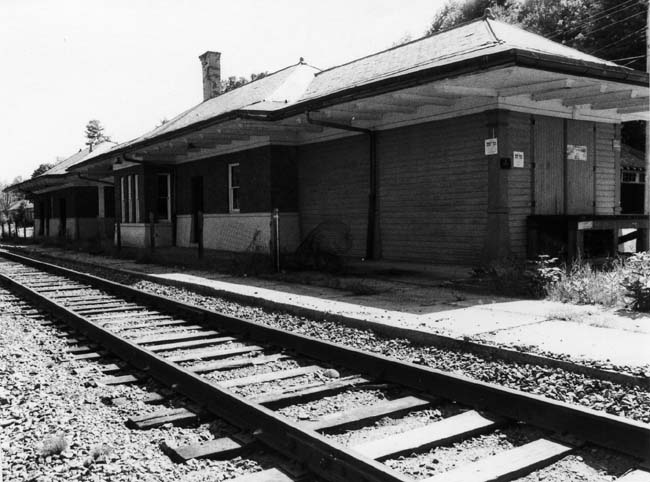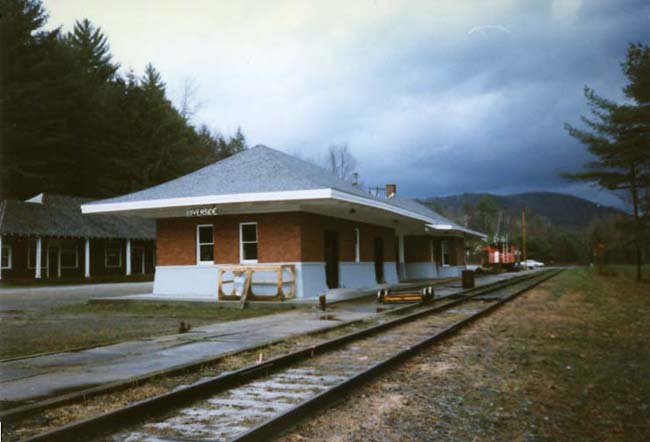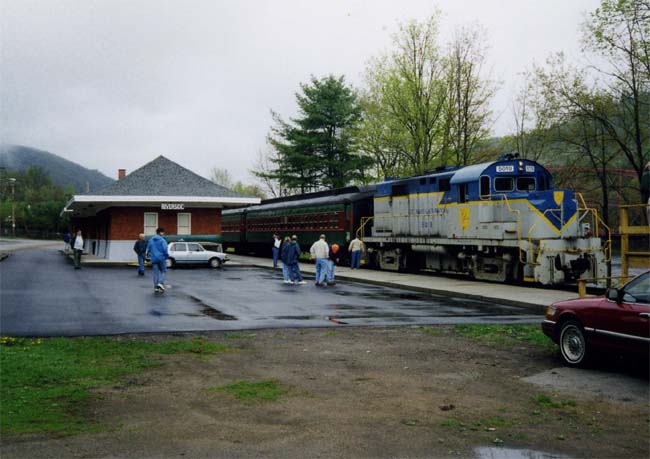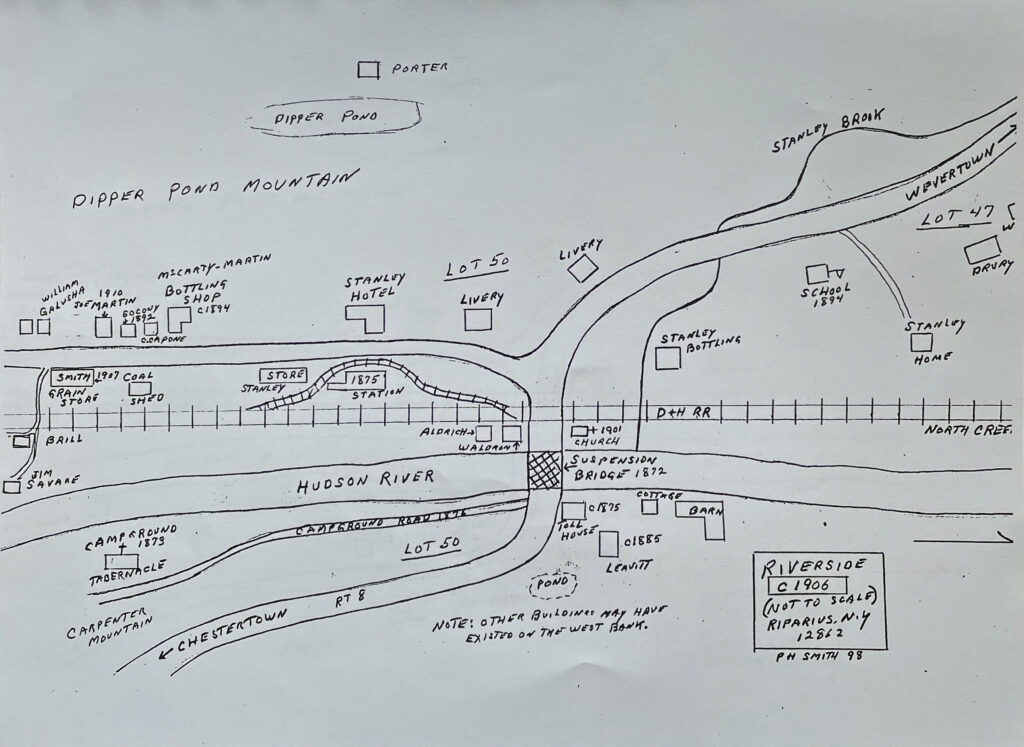Updated June 5, 2024
Overview
Riverside was a hamlet that was part of Johnsburg, New York and west of Chestertown, New York. The area has a rich history dating back to precolonial days. [1]
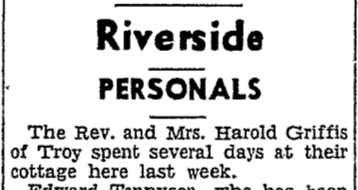
The sleepy hamlet soon became a locus of local development in the late 1800’s with the advent of summer religious camps, the building of a bridge over the Hudson River, and the completion of the northern terminus of the the Adirondack Branch of the Delaware & Hudson Railroad. The Adirondack Railroad arrived at Riverside in 1870. Construction of a one-lane suspension bridge with wooden towers at each end was built in 1871-1972. The camp ground was organized in 1871-1872. To preclude a conflict with another community in New York bearing the same name of Riverside, the village name was changed to Riparius when the U.S. Post Office was established in 1886. However, despite the name change, the railroad station was named “Riverside”. [2]. Riparius in Latin means “belonging to a river bank”. [3]
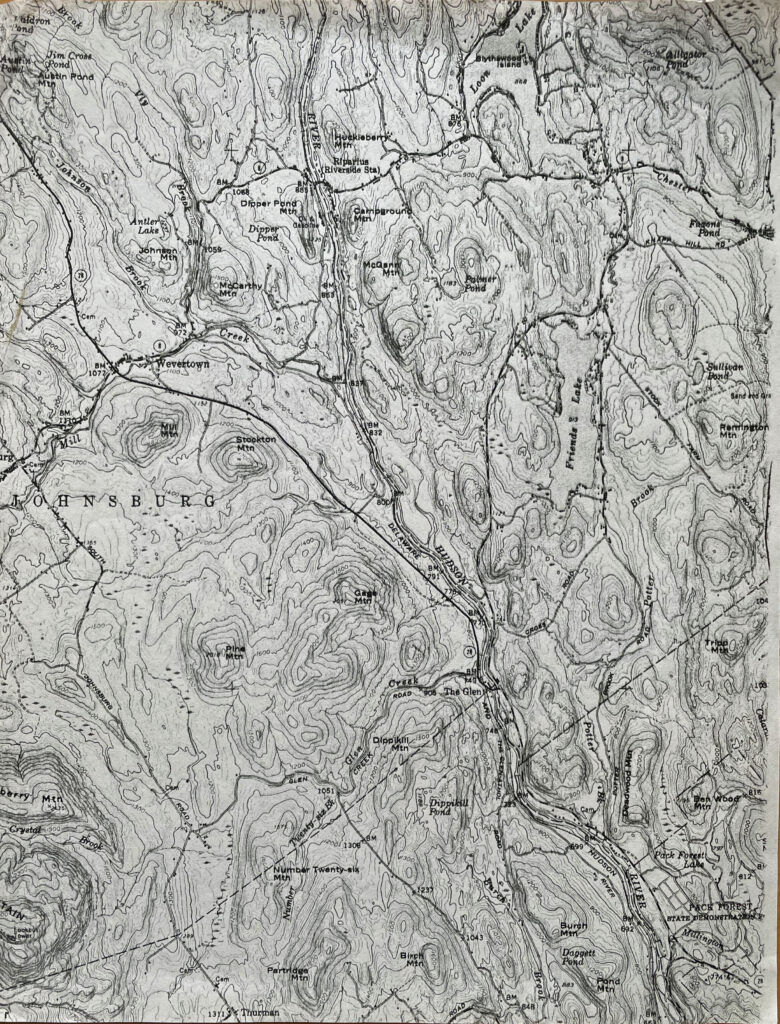
While the name may have changed through time, the small campsite area on the east side of the Hudson River became a spiritual locus for Evelyn and Harold Griffis and a summer family anchor point when they started a family. Since the 1920’s and perhaps when they were in high school, Harold and Evelyn Griffis spent time in the summer months in Riverside, New York as participants of the Epworth League camp functions.
When they started a family, it is believed that they initially rented cottages at the Riverside campsite for summer vacation. Eventually, an opportunity arose and they purchased a camp cottage at Riverside to enjoy family time in the summer months in the 1940’s. They owned the camp cottage for seven years at Riverside. They sold their cottage in 1949. After 24 years, their son John Griffis bought the cabin back in 1973. The cottage has been in the family since 1973.
The following photograph, taken around 1937 at the Riverside Camp. It is a photograph that provides an indication of ‘date stamp’ of their time at the Riverside Campsite with their family. Their oldest son, James Dutcher Griffis is sitting on the back of the wagon while brother John Harold Griffis is sandwiched between two young girls on the wagon. The Reverend Cassius Miller’s camp is in the background which is located on the Hudson River.
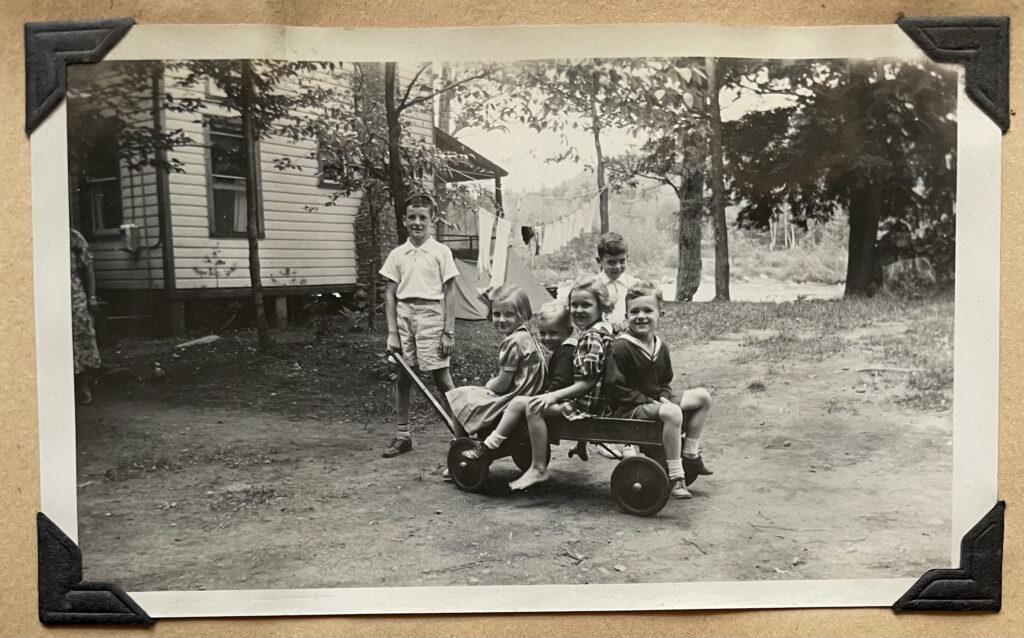
Harold and Evelyn rented a cottage from the Reverend Cassius Miller, one of Harold’s peers in the Troy, New York conference of the Methodist Episcopal church in 1941. Harold had phlebitis in the legs, thrombophlebitis, and was advised to keep off of his legs. For a summer, he and the family stayed at Cassius Miller’s Cottage.
The following photographs were taken while Harold was convalescing at Cassius Miller’s cottage. Evelyn took the photograph. Harold is peaking our of a window where a day bed was placed. Young James is on the porch steps and young John is making a face standing next to his brother. Grandfather George Griffis is kneeling. Grandmother Ida, Harold’s mother is to the right of the window. Evelyn’s mother, Mary Jane Dutcher, is on the right.

The photograph below is a variation of the above photograph. Young James took the photograph. From left to right: Evelyn Griffis, Mary Jane Dutcher, John Griffis, Ida Griffis and George Griffis; Harold is peaking through the bed stand in the window.
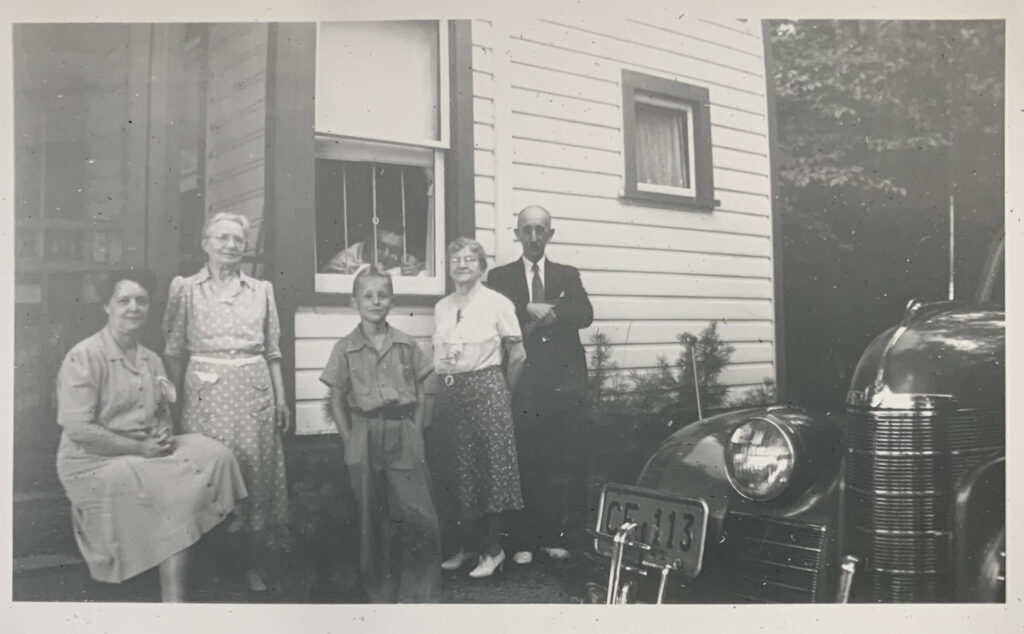
Click for larger view.
The following photograph captures a page from one of Evelyn’s scrapbooks. The top photograph is a photograph of one of the administrative buildings near the Tabernacle located at the Campgrounds. The building originally was the boarding house which accommodated campground visitors that did not havre overnight supplies. This building had a kitchen and a dining room on the ground floor and sleeping rooms on the second floor. This building remains today and was extended on the front end and serves as the “Administration Building”. [4] The second photograph is a view of the Miller camp cottage that the Griffis family rented in the early 1940’s. The view is from the Hudson River, looking at the back screened in porch.
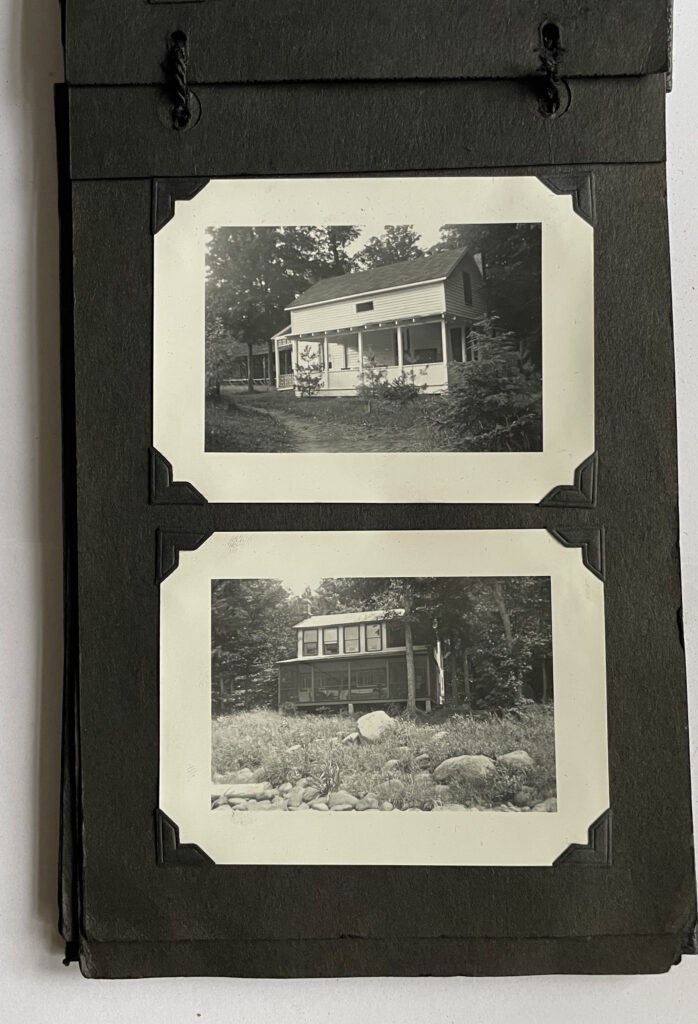
Singing River – The Griffis Family Riverside Cabin
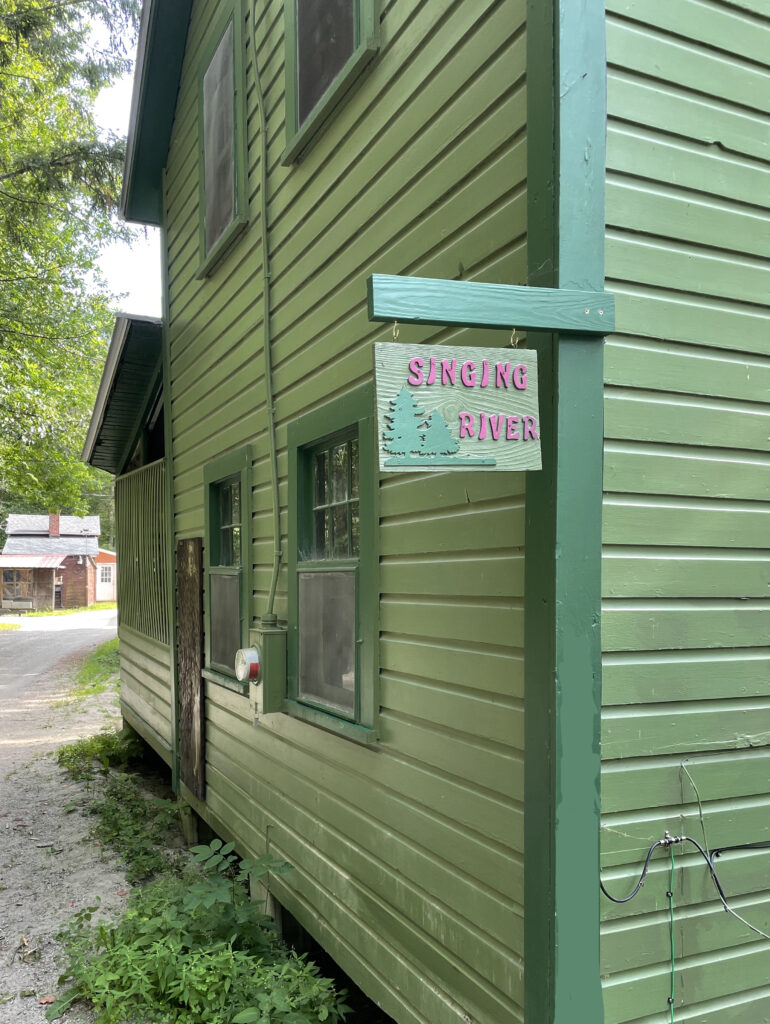
Singing River is the ‘name’ of the cottage or camp cabin that has been in the Griffis family name off and on since 1942. The camp cabin has been in the family’s possession from 1942 – 1949 and from 1973 to the present (2021). The name was given to the camp by an intermediate owner, Edith Ford, who owned the camp between 1949-1973.
While staying at the Miller cottage, Harold and Evelyn was acquainted with the Miller’s next door neighbor. In 1942, Harold and Evelyn became aware of the availability of the cottage next to the Miller camp. They purchased the cabin from Edelbert J. and Susan Lennon on September 28, 1942 for $600.00 [5] and [6]. At the time Harold and Evelyn and their two sons, James and John, lived at 34 Division Street, Amsterdam, New York.
Harold and Evelyn’s ‘singing river’ was a piece of property described as: “starting at the south line of the Riverside campground on the bank of the River at high water mark, and continuing along the bank of the River in a southerly direction as it winds and turns fifty (50 feet, turning thence east and continuing in an easterly direction on a line parallel to the south lone of the camp ground one hundred and fifty (150) feet, then turning and going in a northerly direction with a line as near parallel to the west line as possible fifty (50) feet; thence in a westerly direction along the south line of the camp ground one hundred and fifty (150) feet to the place of beginning.” [7]
Harold Griffis modified the deed in 1947 to include Evelyn’s name. On August 12, 1949 Harold and Evelyn sold the property to Edith E. Ford for the sum of $1,500 [8].
Evelyn Griffis’ son, John H. Griffis made arrangements with Edith E. Ford to buy back the cottage for the Griffis family. While the warranty deed of the sale indicates that Edith sold the cottage on June 25th 1973 to Evelyn T. Griffis for the sum of one dollar, [9] Edith Ford accepted a cash payment of $3,500. According to family folklore, Edith originally offered the property for $5,000 but Evelyn thought it was an unconscionable offer since “we originally sold the property for $1,500”.
The original plot of land that the cabin resides was owned by Milo D. Knapp. Knapp purchased a large parcel of land that included many of the present day camps in the late 1800’s. On February 2, 1906 the estate of Milo Knapp sold the land to Herbert F. Stanley. [10]
The Knapp Estate sold a large track of land just south of the Riverside campgrounds: “All that Tract or parcel of land situate in the Town of Chester,, County of Warren and State of New York, being a part of lot No. 49 in the Twenty fourth Township of Totten &: Crossfield ‘s Purchase, bounded and described as follows. Commencing at a stake and stones at the east side of the Hudson River below Riverside Camp Grounds, running thence east three chains to a stake and stones, from thence south ten chains to a stake and stones, thence west to the bank of Hudson River at high water mark, thence up the river as it winds and turns to the place of beginning, containing three acres of land, be the same more or less.
“Also all that other piece or parcel of land in said Township, Commencing three chains and twenty·five links, south from the northeast corner of the above described lands and running two chains and twenty five links to a road leading from the, Riverside Camp Grounds to McHann’s clearing, thence south along said road three chains and fifty links to a large rock, thence to the east bounds of said lands first above described, thence north on the line of said above described lands to the place of beginning, containing one half acre of land, ee the same more or less…” [10]. (The chain is a unit of length equal to 66 feet (22 yards). It is subdivided into 100 links. [11].)
Herbert F. and Bertha E. Stanley in turn sold the lot to Homer Slivernail on October 1, 1920. [12] In the early 1920’s, the Stanleys began selling smaller lots of the large parcel that they owned along the river. Homer Silvernail originally was a Methodist minister [13] and built the two story cabin. He also purchased another lot from the Bertha Stanley after Herbert passed away in 1921 [14]
The following is a newspaper article that was written by Albert Silvernail, one of Homer Silvernail’s sons. It was a recurrent column in the Albany, New York Times-Union newspaper entitled “I remember”. It describes his experiences living at the Riverside Campground. Albert lived a along life; he passed away just before his 100th birthday. [15]
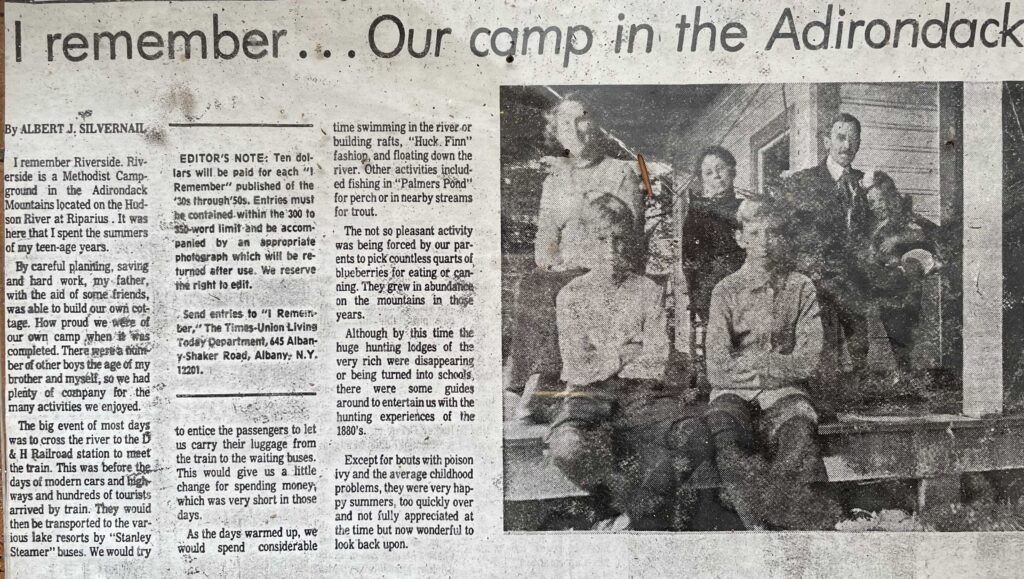
The Lennon’s originally purchased the land from Moses B. Silvernail by deed October 20, 1920. It appears Silvernail built the cabin and then entered into an indentured land deed with the Lennon’s on April 30, 1921. This was not entered into the county ledger until November 14, 1933.
“This indenture, made the 30th day of April, nineteen hundred and twenty-one Between Homer B Silvernail and Mabel Silvernail, his wife …and Adelbert Lennon…do hereby grant and release all that piece or parcel of land. Being the same property conveyed to Homer Silvernail by Herbert F. Stanley and wife by deed dated October 12, 1920. This was entered into the county ledger November 14, 1933.” [16]
Here is a summary of the ownership of the parcel of land referred to as ‘Singing River’:
| Date of Deed | Grantor | Grantee |
| Feb 2, 1906 | Estate of Milo Knapp | Herbert F. Stanley |
| Oct 12, 1920 | Herbert F. & Bertha E. Stanley | Homer B. Silvernail |
| Apr 30, 1921 | Homer B. & Mabel Silvernail | Adelbert J. & Susan Lennon |
| Sep 30, 1942 | Adelbert J. & Susan Lennon | Harold Griffis |
| Aug 12, 1949 | Harold & Evelyn Griffis | Edith Ford |
| June 25, 1973 | Edith Ford | Evelyn Griffis |
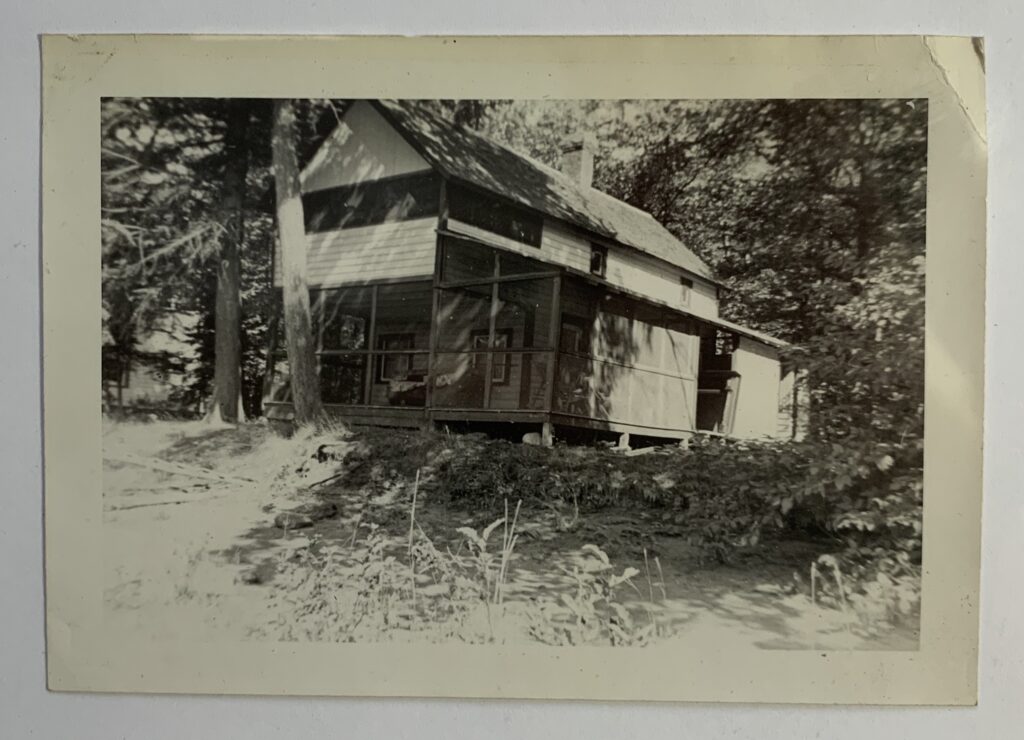
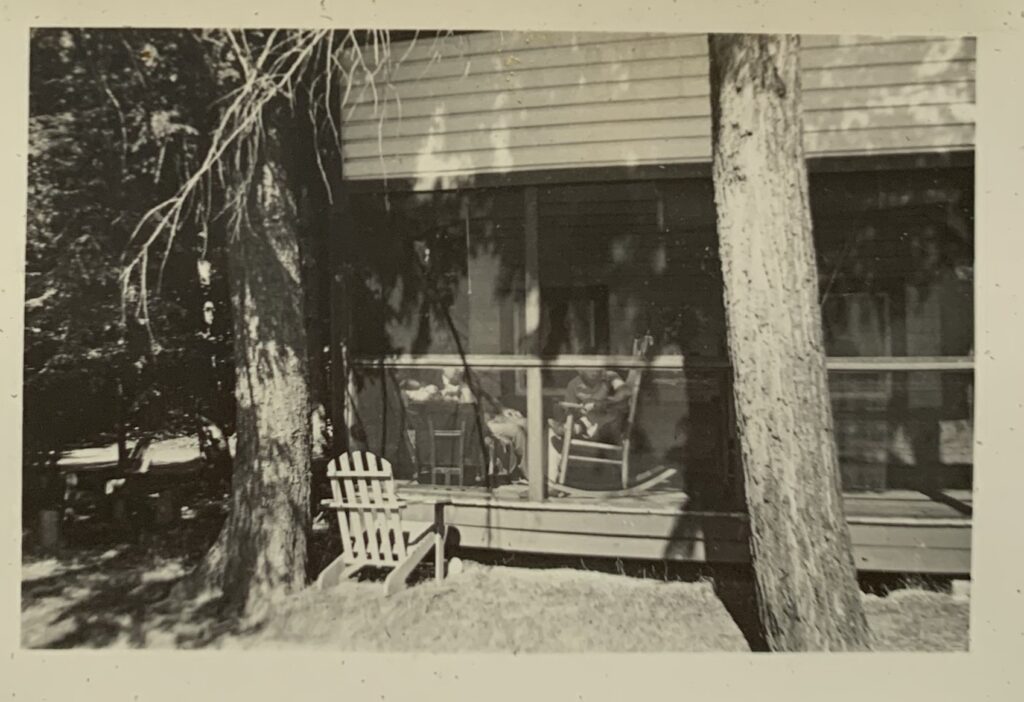
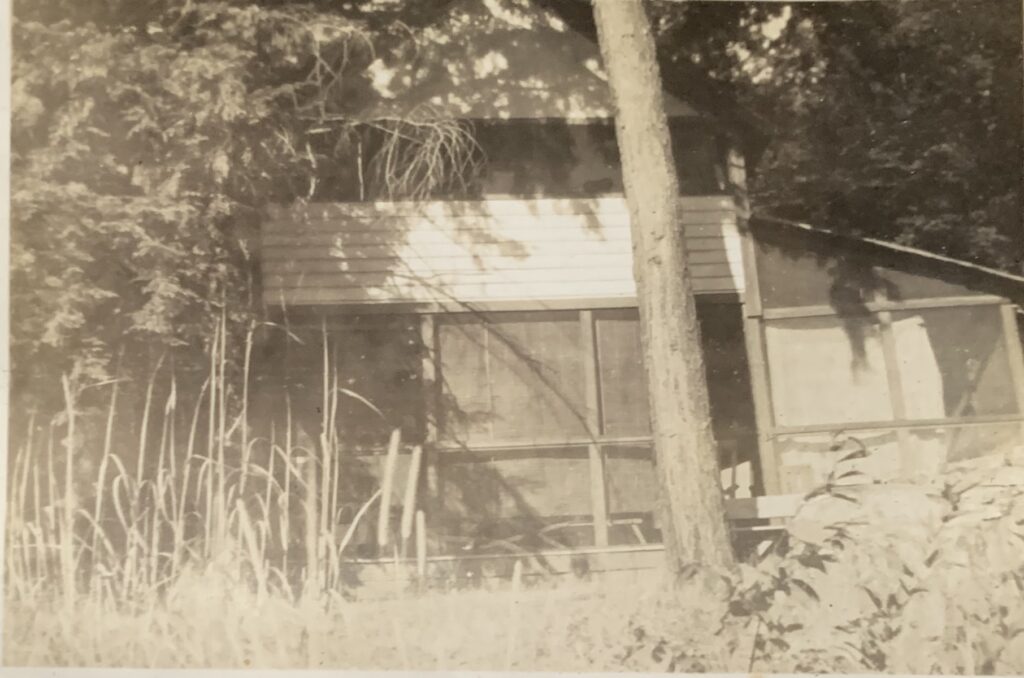
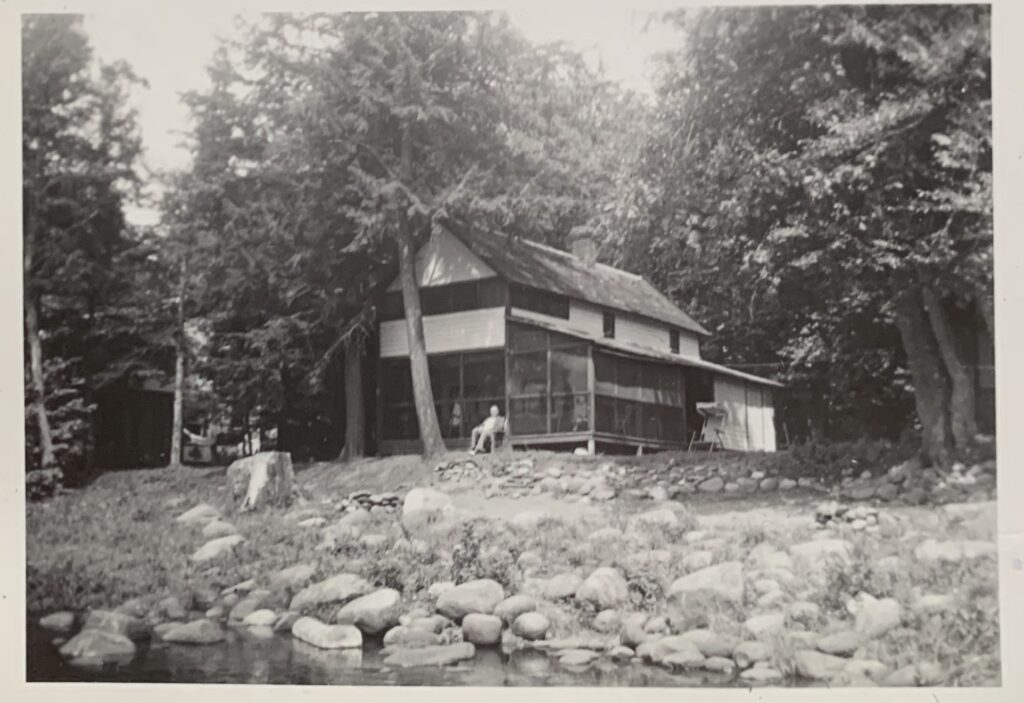
History of Riverside – Riparius
Riverside was formerly called Folsom Landing, named for Jonathan Folsom, who owned land on both sides of the river. When the settlers first came through this territory Folsom established a ferry across the river as a short cut from Chester, New York. In 1863 the Adirondack Railway Company was formed with the plan to extend the rail line north of Saratoga. In 1865 tracks had been laid north to Hadley, New York. The rail line was extended and reached Riverside in 1870. [17] [18]

The first rail station at Riverside was built in 1872. This was in use until the current station was built in 1913. The old station was then moved to the south end of the yard and used for a freight station until its removal in 1956. [19]
The following are photographs of the Riverside Railway stations. [19]
Riverside Railroad Station through Time 1879 – 1999
John Patton has done an amazing job of documenting bridges, railway stations, related historical stories of buildings, the R&H Railway and people in the Adirondacks. Many of the photographs of the Riparius bridges and railway station are from John Patton’s website. I urge anyone who is interested in this part of the country to enjoy his work.
(He) “started this site in 2008 as a means of sharing a growing amount of infomation with others interested in the Adirondack Branch of the Delaware & Hudson Railroad. It is also a means for other people to share their stories and photos with the rest of the world.”
1879 Riverside Rail Station Patton Collection
Riverside Rail Station – 1900 Patton Collection
Riverside Rail Station – 1900 Patton Collection
Riverside Rail Station – 1910 Patton Collection
1910 Riverside Rail Station – Patton Collection
1910 Postcard of Riverside Rail Station – Patton Collection
1915 Riverside Rail Station
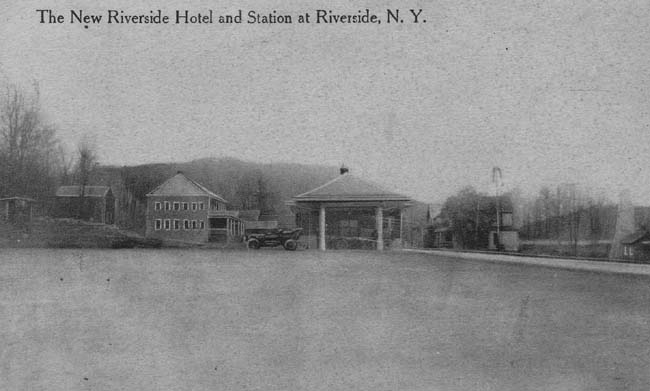
1915 Riverside Rail Station
1915 Riverside Rail Station – Patton collection
1918 Riverside Rail Station -Favo Collection
1918 Riverside Rail Station -Walt Favo Collection
1920 Riverside Rail Station
1925 Riverside Rail Station -Philip Smith Collection
1935 Riverside Rail Station – Philip Smith Collection
1943 Riverside Rail Station
1936 Riverside Rail Station
1949 Riverside Rail Station
1983 Riverside Rail Station
1983 Riverside Rail Station
1997 Riverside Rail Station
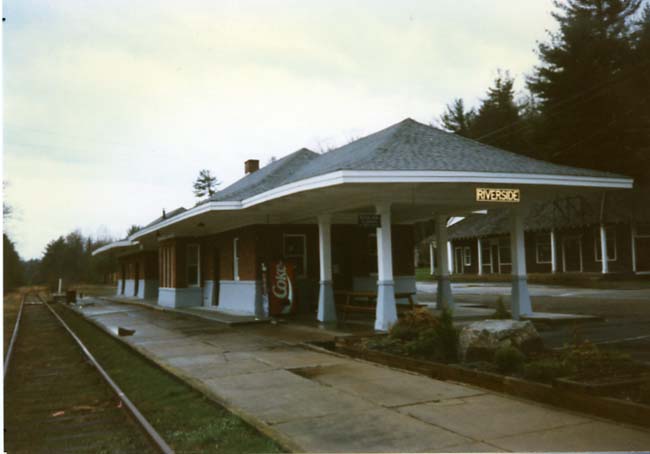
1997 Riverside Rail Station
1999 Riverside Rail Station
Although the rail line is not longer in use, the 1913 Riverside Rail Station still exists and is part of the U.S. National Register of Historic Places.
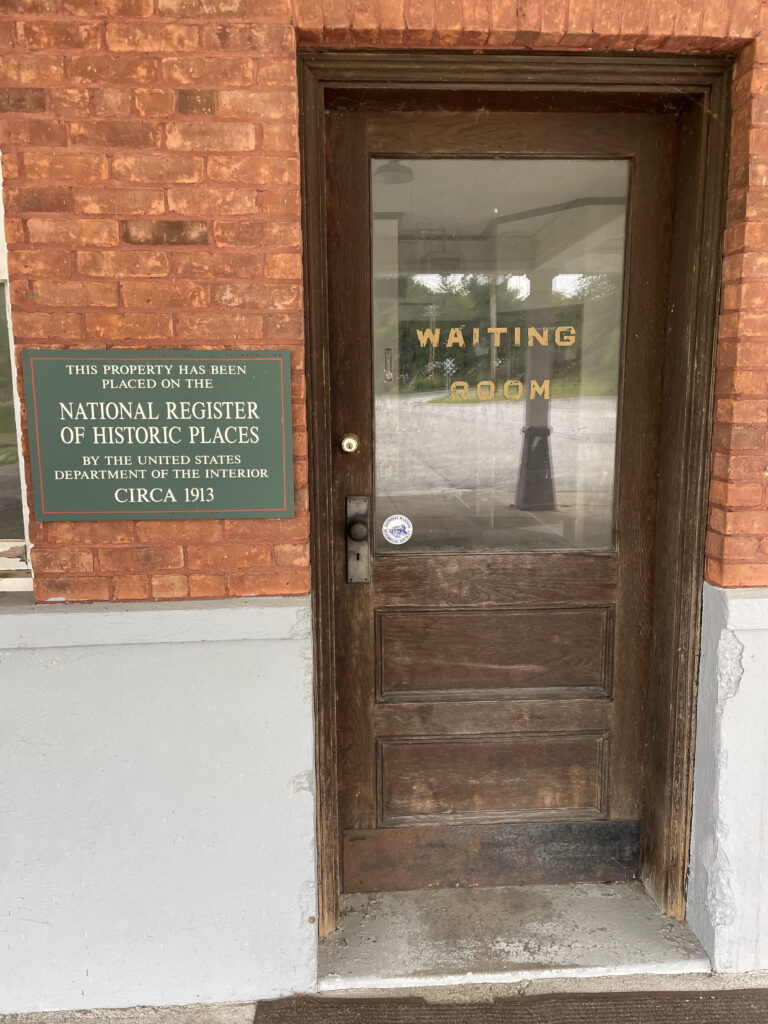
The first school meeting in Riparius was held on April 13, 1894. Those attending the meeting voted to build a school house. Seymour Armstrong donated the land and $500 was raised to construct and outfit the schoolhouse. It was completed in August 1894. Prior to the establishment of the school house, children attended school in Weavertown or the Millington district about three miles north of Route 8 on the River Road. [17]
The first post office, established February 24, 1886, was in the Delaware & Hudson (D&H) Railroad station. After many moves and several postmasters, the post office now resides next to the Riparius firehouse.
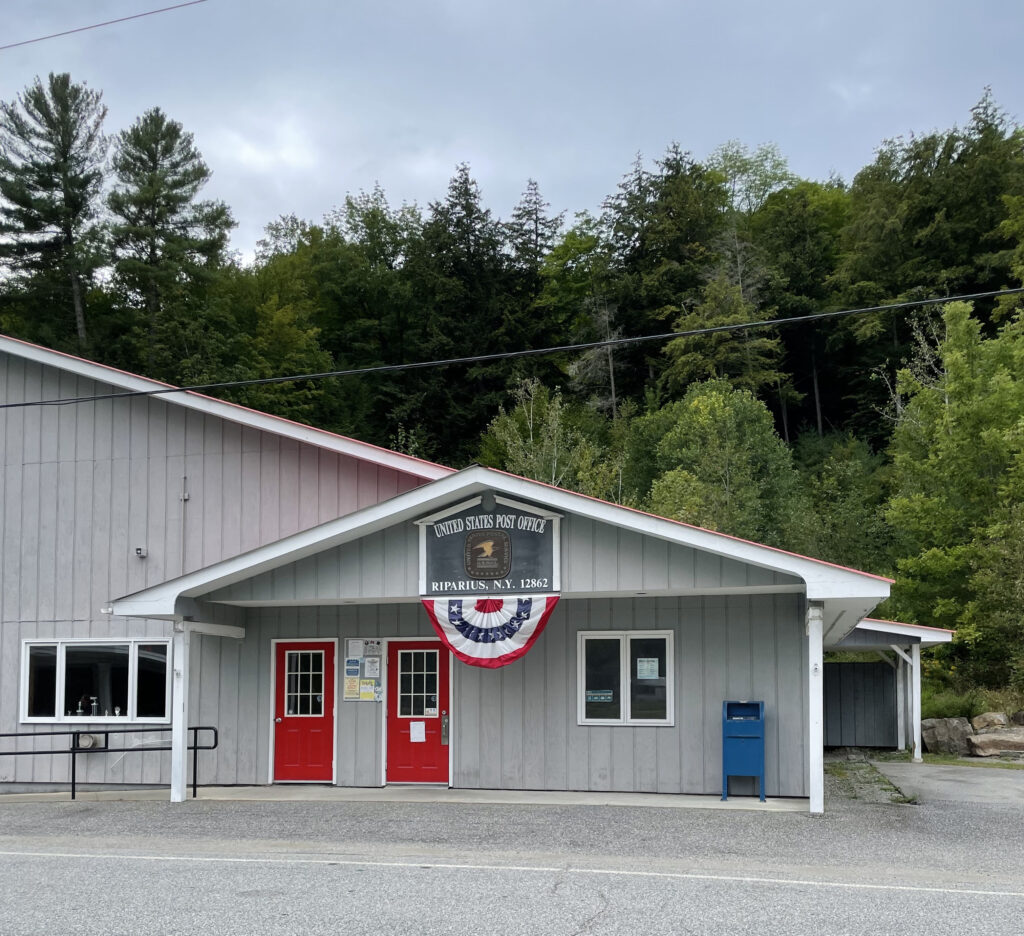
It is interesting to note that the Methodist Church in the local community was built in 1900 on the west side of the river near the railroad tracks. When the bridge over the Hudson was replaced in 1919, the church was moved across the river to the east side, its present site. The photograph below reflects the location of the church on the northwest side of the bridge before it was moved. [21]
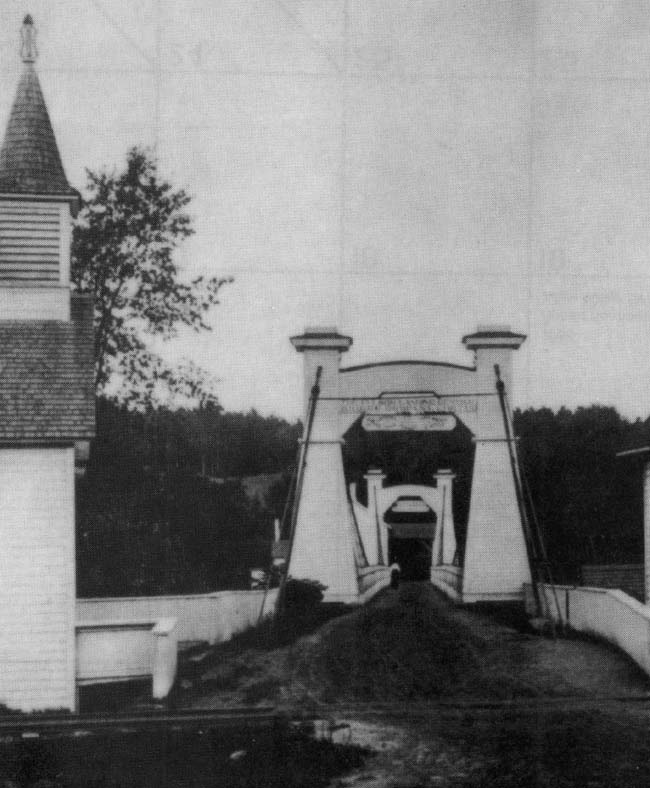
The following contemporary photograph is of the same church building on the south east side of the bridge on the Hudson River.
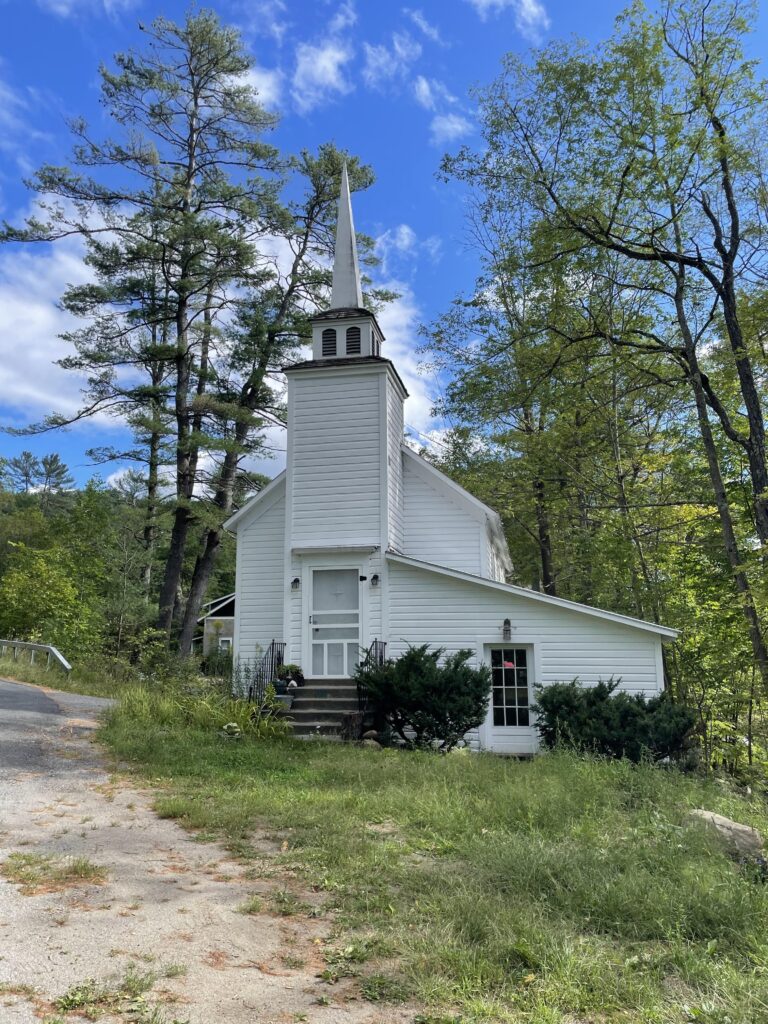
The original grain store built in 1893, south of the railroad station, operated until it burned in 1930 and was rebuilt the same year. Downriver there was a small factory that made bowling pins which also burned down.
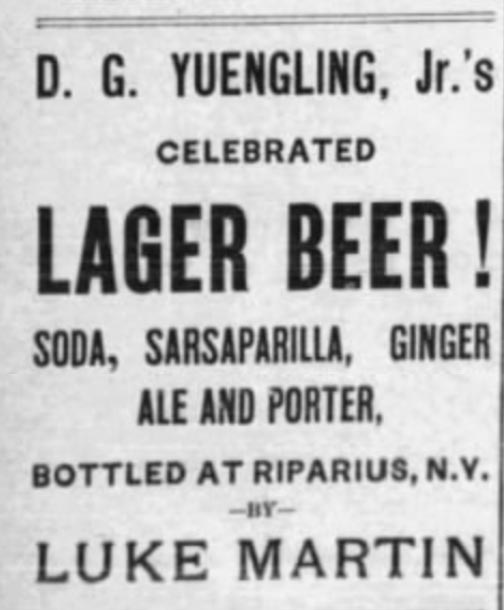
The Standard Oil Company established their plant at Riparius in 1892. The name was changed from Standard Oil Company to Socony Vaccuum Oil Company in 1933. At the present time the buildings are no longer in use.
D.C. Yuengling briefly had a brewery in Riverside (Riparius) in the 1890s. [21] A bottling works also partly owned by Yuengling and a Mr. Martin was built near Stanley Brook close to the railroad tracks. [17]
A creamery was built near the railroad tracks around 1917, and was to take care of the farmers’ surplus cream. The business failed due to low demand for the product. The farmers also felt they were not paid enough for their cream. [17]
A late summer fire in 1947 in the southern part of this hamlet spurred the community into realizing a fire department was necessary. A meeting was held to discuss organizing a fire department and the department held its first annual meeting May 14, 1948. The firehouse was completed in 1954 and is presently staffed by local volunteers.
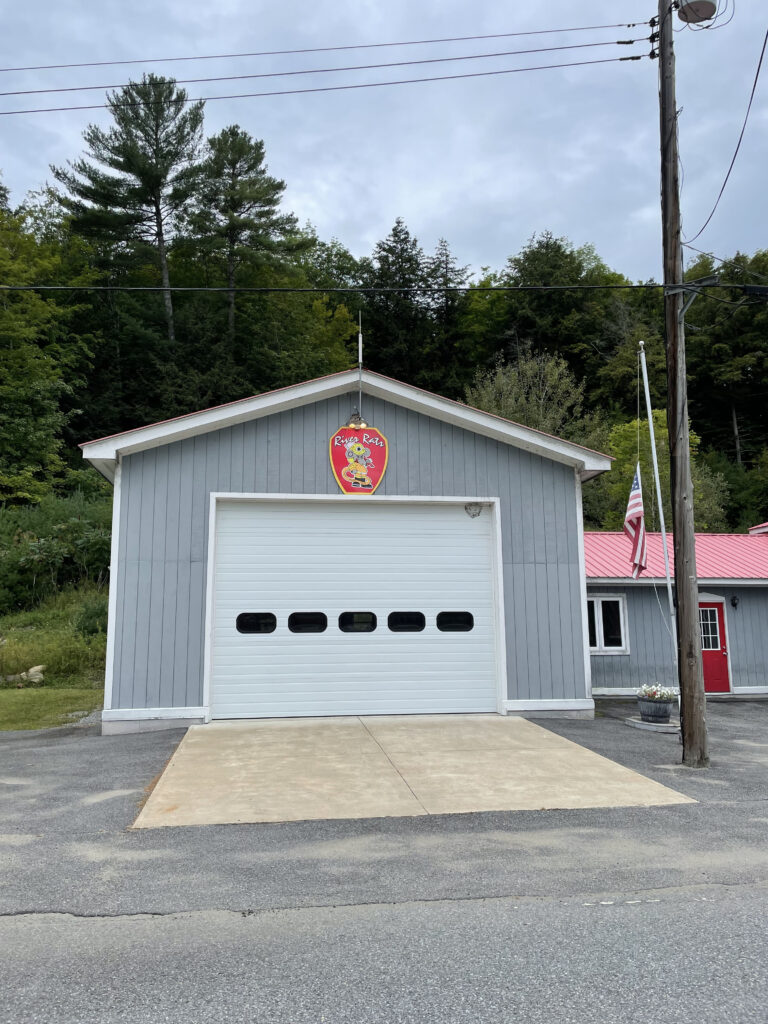
The original Riverside Hotel was located across the road from the railway station and was built in the early 1890’s. It was started by Mr. Yuengling (the developer and owner of Yuengling Beer) with Mr. Martin as proprietor. The hotel was owned by Mr. Herbert Stanley in 1906 (the same individual who owned the track of land that the Griffis campsite is situated) and burned down in 1913. [17]
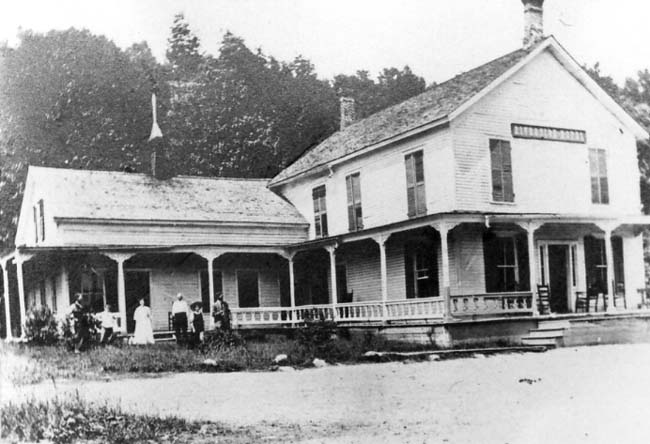
After the hotel burned down, the new hotel was built closer to the railroad station. During prohibition the hotel made an excellent hiding place for rum runners on their way from Canada to places south. The deteriorating hotel was taken down in the 1960s.

A local fixture in the contemporary world of the Riparius area is the T.C. Lumber Company, a hardware and building materials store and storage area. Philip Moston purchased the property and in 1888 started building a dam and sawmill. In 1913 the Moston business was purchased by T. C. Murphy and it became known as T. C. Murphy Lumber Company. At Timothy Murphy’s death in 1925, his son, James Murphy, managed the mill and established a retail lumber and building supply store. Mr. Murphy sold the business to George Van Voorhis in August 1962. After his death in 1982, Rudd Van Voorhis, his son, operated the business. [25]
The American Experience of Religious Camp Meetings
The history of the Riverside Campground should be viewed in a wider, historical context of a wave of religious camp meetings that were popular in the 1800’s in the United States. As the name implies, those who attended such meetings came prepared to camp out. Camp meetings gathered at prearranged times and places. The theology of the preachers varied depending on who was sponsoring a specific camp meeting. People typically traveled from distances as far as 30 to 40 miles away. Families would pitch tents around a forest clearing where log benches and a crude preaching platform constituted an outdoor church. The camp meetings typically remained in constant session for three to four days. Various newspaper articles reported as many as 10,000 to 20,000 people at some of these meetings in the 1800’s. Typically the size of these camp meetings in their heyday were family large gatherings of 1,000 to 2,000 individuals. People came partly out of curiosity, partly out of a desire for social contact, and for religious worship. [26]
The camp meeting is a phenomenon of American frontier Christianity. Originally camp meetings were held in frontier areas in the late 1700’s and early 1800’s. People in frontier areas were without regular preachers and would travel to a particular site to camp, pray, sign hyms and listen to preachers. Camp meetings offered a sense of community through activities such as singing, music, sometimes dancing, and diversion from the daily travails of work. [26]
The practice was a major component of what was called the Second Awakening, an evangelical movement promoted by Baptist, Methodist, Presbyterian and other preachers in the early 19th century. [27] For the initial wave of American Camp meetings, the single religious purpose of camp meetings was conversion.
While they were primarily religious in character, camp meetings were festive affairs. They typically were held annually or coincided with a time when farm life did not require daily attendance to crops. For frontier children, the camp meeting was often their first experience of religious community.
The Methodist Episcopal church profited most by their popularity and gradually institutionalized them into its system of evangelism. By 1811 the Methodist bishop Francis Asbury reported in his journal that over 400 camp meetings were held annually along the frontier from Georgia to Michigan. Revivals and camp meetings continued to be held by various denominations. In some areas it led to the development of seasonal cottages for meetings. [26]
“As the nineteenth century wore on,” one historian writes, “camp meetings gradually fell into disuse. After the Civil War they were revisited and once again became somewhat popular.” [28]
Religious conferences formed the next major branch in the development of religious camps. For example, the Chautauqua Conferences were founded by Methodists at Chautauqua Lake in New York as a training institute for Sunday school teachers. They focused on education within the life of the church rather than a singular focus on personal salvation. [29]
Rather than meeting in remote locations as before, this resurgence of camp meetings in the late 1800’s and the early 1900’s often included building more permanent structures for recurrent seasonal use. Many Methodist camp meeting structures still in use were built during this period that lasted through the late 1800s. [28]
By the late nineteenth century, most rural communities had established congregations. The mainline churches tended to disassociate themselves from emotionalism, hucksterism, and potential “sheep-stealing” that characterized some camp meetings. In addition to the conference based camp meetings, denominational based revival meetings thus began to replace the general camp meeting in many traditions. [30]
The promise of a skilled preacher or structured daily programs and a large gathering of people created a highly attractive event for local communities. Due to the use of horse driven wagons as a major means of transportation of the time, meetings often involved families leaving home for several days, usually camping out near the site. The meetings represented a kind of vacation from the day-to-day routines, a chance to meet old friends, family, new acquaintances, and even prospective marriage partners in a religiously-based atmosphere, as reflected at the Riverside campsite:
“CUPID AT RIVERSIDE CAMPMEETING – Isaac Andrews and Rebecca Dalaba of Baker Mills, were married on the closing day of the Riverside camp meeting by Rev. C L Hall. Over 1,400 people had attended the cammpmeeting during the previous ten days.” [31]
The History of the Riverside Campground
The Riverside campground is located on the east side of the Hudson River, one half mile south of the bridge at Riparius, Warren County, New York.
H. P. ( Henry Perry) Smith wrote a comprehensive history of Warren County New York which was published in 1885. Smith refers to the Riverside campground in a footnote while discussing the construction of bridges over the Hudson River near Chester, New York:
“To the south of the bridge on the east bank of the Hudson, and completely hidden from view by the trees is the encampment of the Riverside Camp – meeting Association. There stands in two circles – a wheel within a wheel. about one hundred cottages and a hotel of comfortable dimensions. The Methodists from this part of the country hold their annual camp meeting there a week every August, and have done so for the past twelve or thirteen years.” [32]
For a detailed personal history of the Riverside Campground, read a short article written by Glenn Fish, entitled The Campground. Glenn Fish lived on the campground from 1966 to 1992. It is an highly informative article that originally was part of a self published document compiled by Philip Smith. [33]
For a comprehensive compendium of newspaper articles on the campground from 1874 – 1974, See: Newspaper Articles on the Riverside Campground [34]
Philip Smith grew up in the home immediately south of the Riverside church overlooking the Hudson River and on the road to the campground in the late 1920s to the 1940s. His personal memories were documented in a self published memoir and provides a unique perspective on the Riverside Campground. See Campground Memories by Philip Smith. [35]
The following are hand drawn maps of the Riverside area in 1906 and in 1925-1945 by Philip Smith [33]. For larger views of the maps: Riverside in 1906 | Riverside in 1925-1945 .
The camp ground was organized in 1871-1872. During the 1870s camp meetings for religious and revival services were very popular in the Warren County area and attracted large gatherings of people in the Adirondack area. Usually the location selected for such meetings were in wooded areas near a lake or river. Camp meetings were held in Pottersville and attracted attendance by a number of the Johnsburg Methodist church congregation. Johnsburg is a town, in Warren County and Riparius was part of the town [36]. The Johnsburg congregation desired a meeting location for their annual camp meetings nearer their own village.
“According to tradition, the Reverend Aaron Hall, then pastor at Johnsburg, started out on Monday morning, together with a few parishioners, to search for a level spot he had been told about on the east bank of the Hudson River, downstream from the site of the present bridge. Wading across the river, and heading downstream under the shelter of Campground Mountain, the party soon located a well-wooded area of nearly ten acres onlevel ground. The members of the party were soon convinced that the area was suitable and Reverend Hall sought out the owner of the property and inquired about possible acquisition of the land. After reporting to the Johnsburg congregation, and receiving its support, Rev Hall arranged the purchase of the plot from the Carpenter tract and the beginning of the Riverside Camp Meeting Association was under way.” [37]
It was built as a meeting place where ministers could preach and families could arrive by horse and wagon and camp. Families would pitch their tents and the horses were unhitched and tied to trees . Some came only for the day. At the end of a given day, there was a long line of wagons leaving the camp site. Others would stay overnight and tent sites available. A barn was erected to stable the horses (just east of the East Hudson River Road and north of where the baseball field presently exists). Hay was provided for the horses but families needed to bring oats for their animals.
The following is a newspaper article in 1874 that reflects the size and impact of the Riverside Camp.
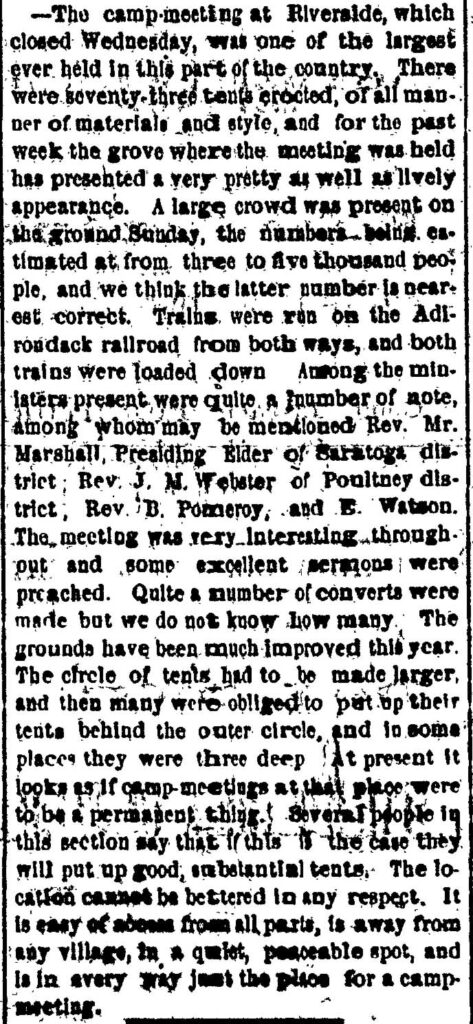
On September 16th of 1875 a meeting of the stockholders of the Riverside camp meeting was held at Riverside and officers were elected. The following were elected as Board Members: T J Carpenter of Chester, E M Barnes of Olmstedville, Columbus Gill of Stony creek, George Leavitt of Chester, H Burnham of Luzerence, John reed of North Creek, and Barclay Thomas of Weavertown. Philip Mosten was elected Treasurer. The officers of President and Vice President were to be elected by the Board. [38]
The establishment of. governing body over the development the Campgrounds coupled with the symbiotic support of the newly developed railway and local commercial establishments near the rail station, contributed to the growth of the annual campground activities.
“The annual camp meeting at Riverside begins this year on Thursday August 22nd and continued nine days. The Adirondack railroad managers have agreed to carry passengers at half fare; board and lodging at moderate rates will be furnished on the grounds, which will be much improved before the meeting commences. The last day will be devoted to gospel temperance.‘ [39]
In September 1890, the campground had 1,500 to 2,000 in attendance for eight days of organized religious activities. In 1895, the camp meeting had been “the most orderly and quietest held there in a number of years. There was no carousing, horse trading or other versions which have been disagreeable features ion the past. From the day of opening to Tuesday noon 2,005 tickets were taken at the gate, including 400 railroad coupon tickets.” [40]
In 1905, a new boardwalk, a half mile long, was built from the railroad station to the camp grounds. The boarding house was equipped with spring beds. Several of the cottages that were built were painted and the general infrastructure of the camp grounds were improved. In 1907, the annual camp meeting of the Saratoga District of the Troy Conference of the Methodist Episcopal Church had an estimated camp attendance of 3,000. Throughout the years, the Riverside camp ground.hosted annual meetings for the Epworth League, the Christian Workers, Junior Leagure Institute, Sunday school Institute training, and various district meetings of the Methodist Episcopal Church.
A photograph taken around 1890, below, provides an illustration of transportation at the camp. A family is driving and leaving from camp with their children and supplies.
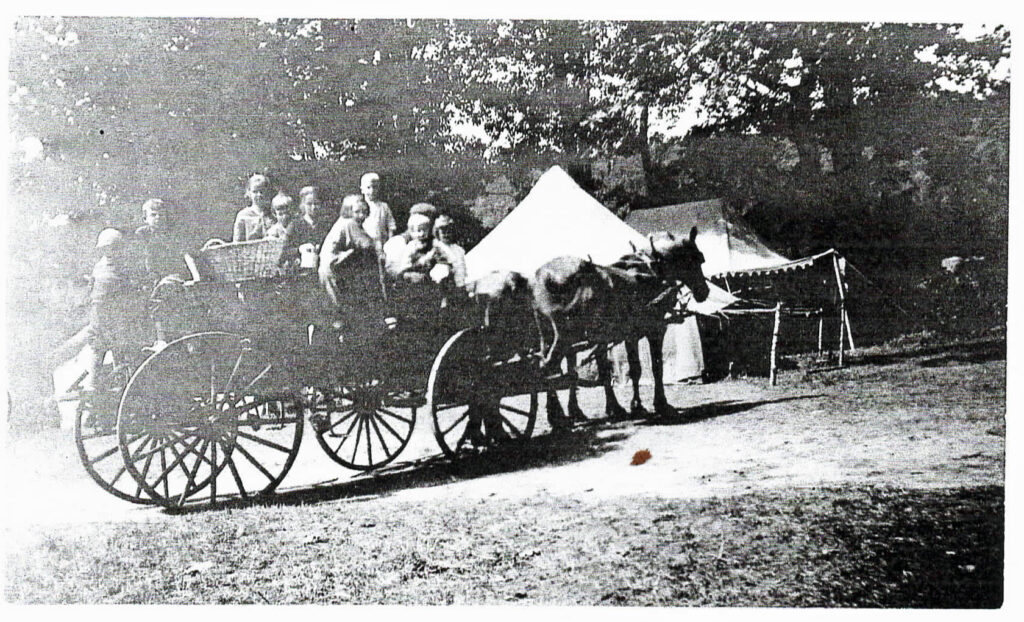
The increase in camp participation required the development of the camp infrastructure by the camp meeting association. In the mid to late summer of 1877, about $1,200 dollars of the Riverside Camp association were expended on the construction of a boarding house and other ‘necessary’ buildings. [41] A Preachers Cottage was also built on the riverside of the circle. The first floor was open for meditation and the second floor was an open dormitory.
When the automobile replaced horse transportation, the barn was moved across the road to the riverbank, windows were installed and two floors and wall partitions were built to created a forl’s dormitory. An heavy snowfall collapsed the roof the dormitory and the site presently is occupied by the recreation building.
Before the 20th century, there was a need for more permanent structures to house camp visitors. Plots of land were assigned numbers by the association and leases were negotiated for99 years. More than 30 small camp cottages ringed the original circle. The structures were primitive wood shelters that typically were comprised of two rooms on the ground floorandone big room on the second floor, divided with curtains. The structures were typically 13 feet by 20 feet set up on stones or posts one foot above the ground. “All were built so close together that passage between them was difficult for all but the many children who found it a good arrangement for a game of hide and seek. [42]
A tabernacle was originally a small platform with a roof over it. This was used as an altar for the ministers. The following photograph was taken around 1900. The tabernacle was originally a simple platform for the minister and the piano.
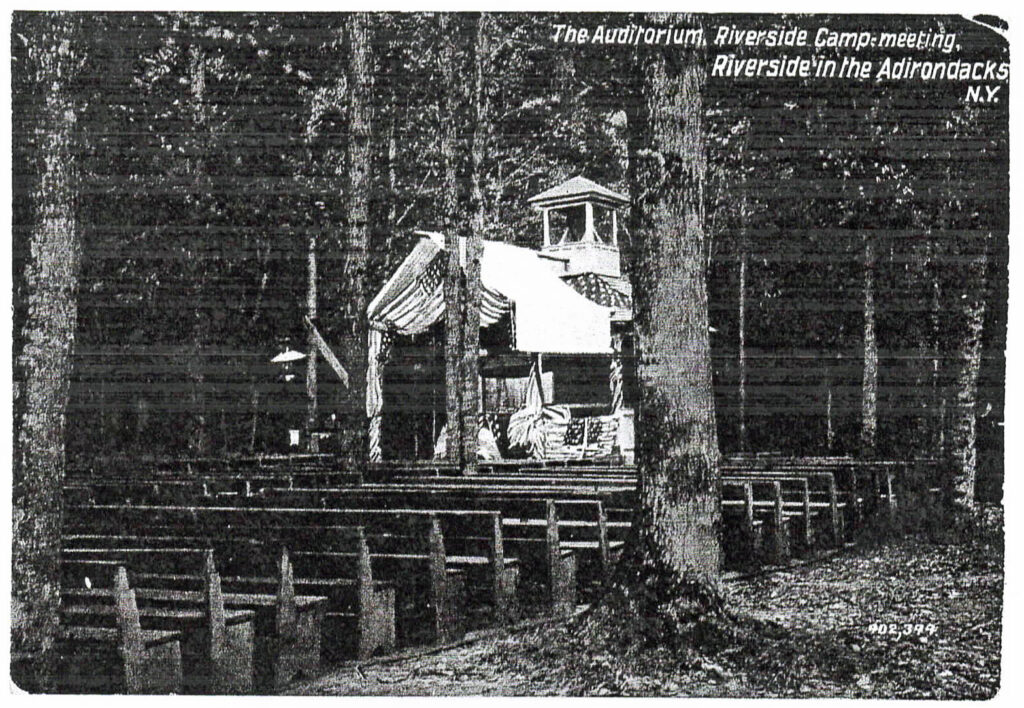
In 1908 the tabernacle was enlarged so people could sit under cover. Methodist ministers would gather for a week in July and preach sermons.
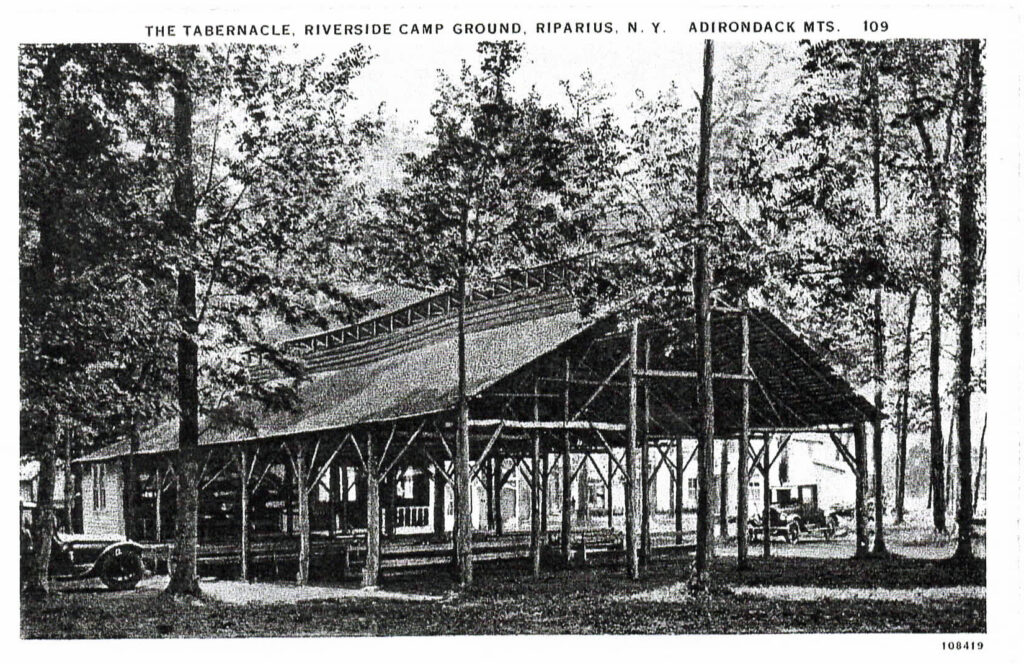


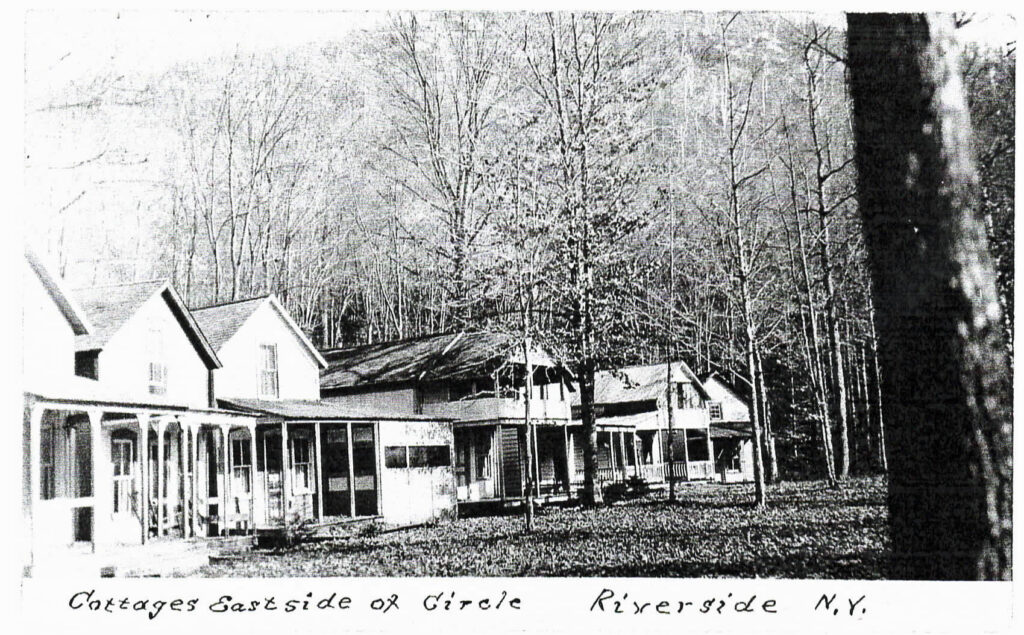
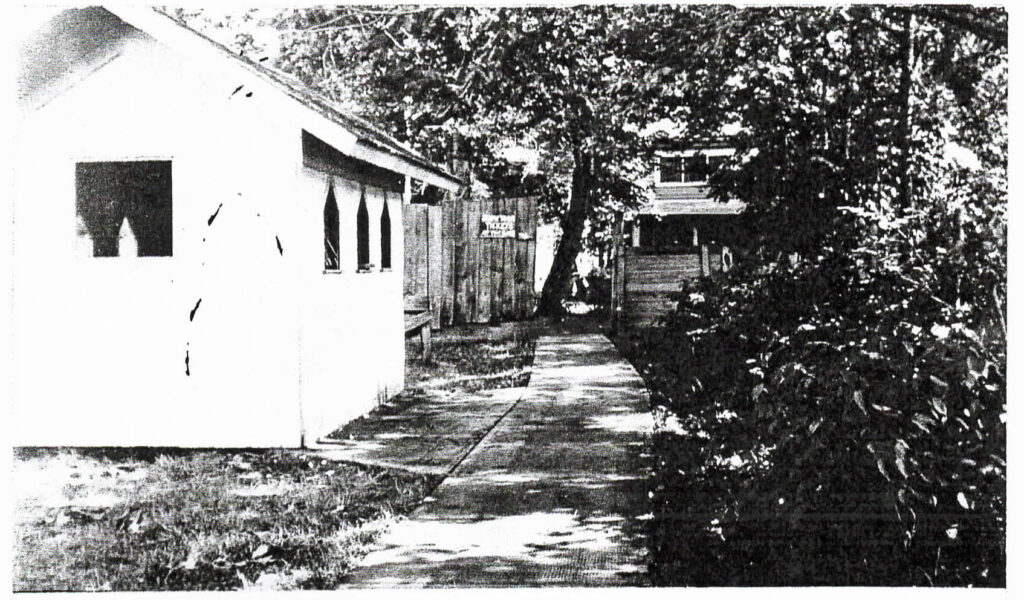
The following photograph taken around 1918 from the top of Dipper Pond Mountain looking east to the Campground or Carpenter Mountain. The long building in the center is T.J. Smith’s grain store which burned down in 1926 with the Adirondack Oil Company across the street. The buildings south of T.J. Smith along the river (to the right in the photograph) is the Jim Savage residence and the house in front of Savage’s is the Brill house. Across the road from the Brill house are the two houses owned by the Riverside gas and Oil Company. The square building north of it is the Riverside Distributing Company , rebuilt in 1915 following the fire. The fire was blown across the river by the Standard Oil Company and Joe Martin’s house are south of the carriage barn. East of the river (on the ‘other side of the river’ in the photograph) is the Methodist campground established in 1873. The dormitory is visible on the north end with the boarding house south of it. Cottages owned by the ministers are seen along the river. Source Adirondack Museum – Cadbury Collection.
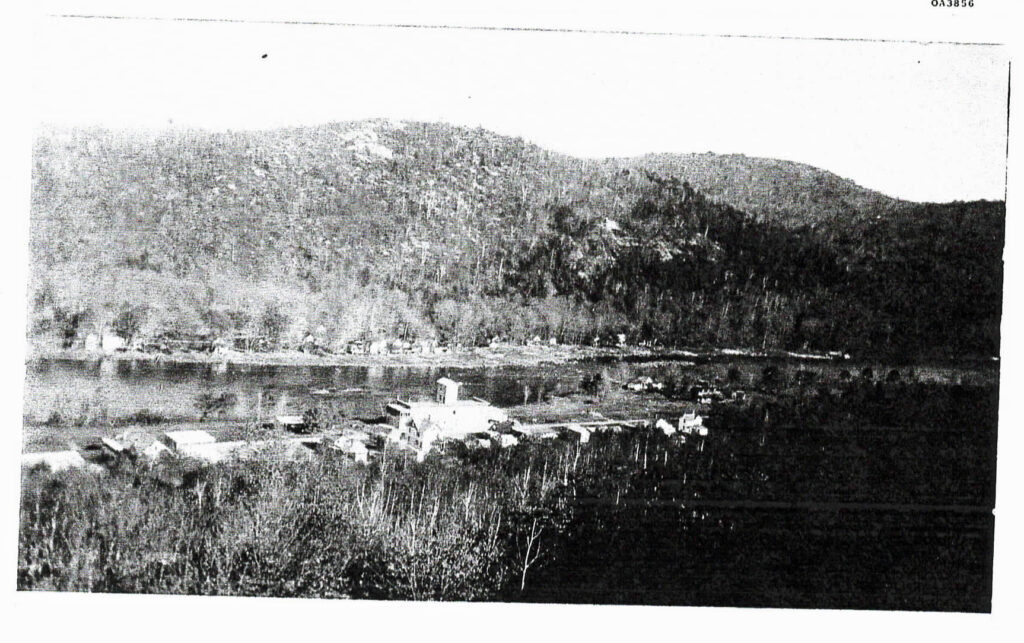
The following photograph taken around 1930 is of cottages that were rebuilt after the fire of 1924. The cottages were spaced further apart from those that burned in the fire.

The Riverside – Riparius Bridge
After many years of fording the river, a strong interest developed for the construction of a bridge over the river. Construction of a one-lane suspension bridge with wooden towers at each end was built in 1871-1972, just as the railroad was built. The bridge was built at a cost of $15,000, and operated it as a toll bridge. In the spring of 1884 the wooden portion was rebuilt at an additional cost of $2,300. [43] Toll rates were three cents to walk across, five cents to lead a horse, ten cents for a one horse rig, fifteen cents for a team, and thirty cents for a ‘tally-ho’. A ‘tally-ho’ was a coach ride across the bridge.
Known as the Fulsom Landing Central Bridge, Warren County purchased the original bridge in 1919. It was replaced a steel structured bridge that was 309 feet long and 10 feet wide.
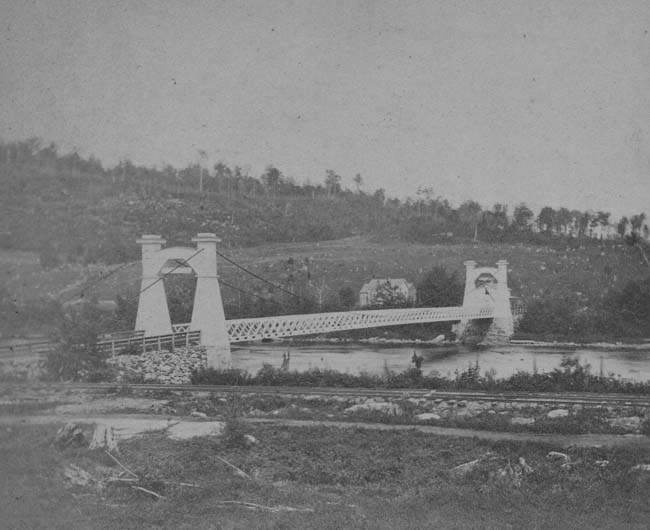
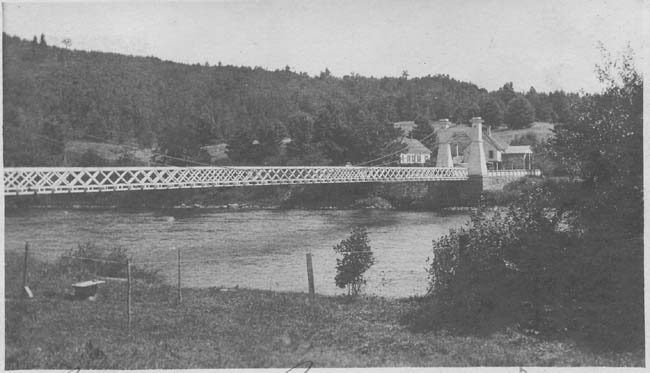
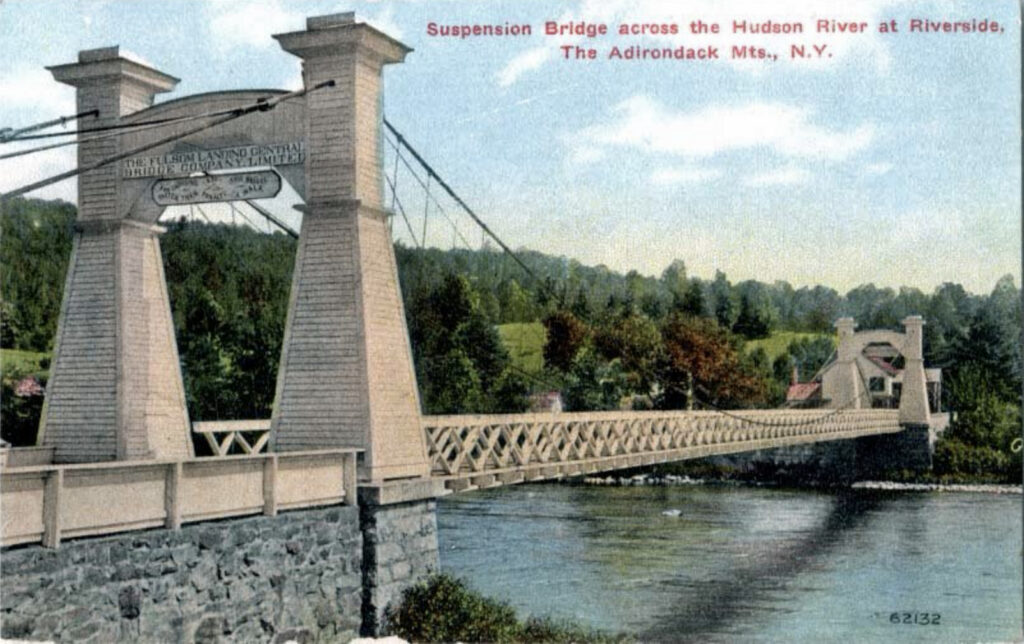
The suspension bridge was replaced with a steel structure in 1919-1920. [43] [44] The second bridge was built in 1919 on the north side of the old one which was removed in 1921. The stone footings remained until this second bridge was replaced in 2003.
Below is a photograph taken by Evelyn Griffis of the construction of the new 1919 steel bridge from the Riparius side of the river in 1920.

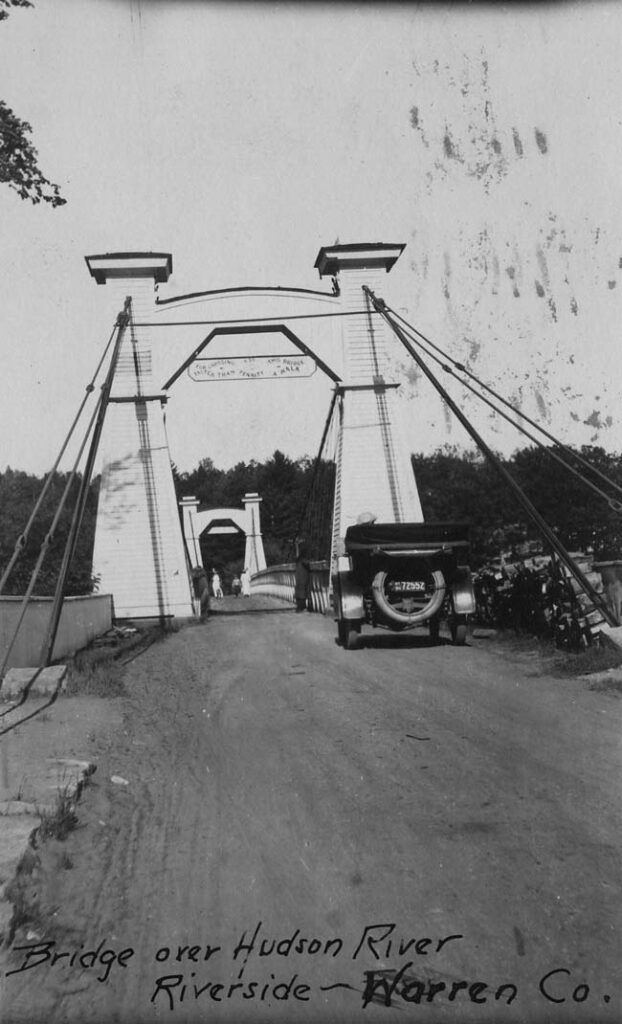
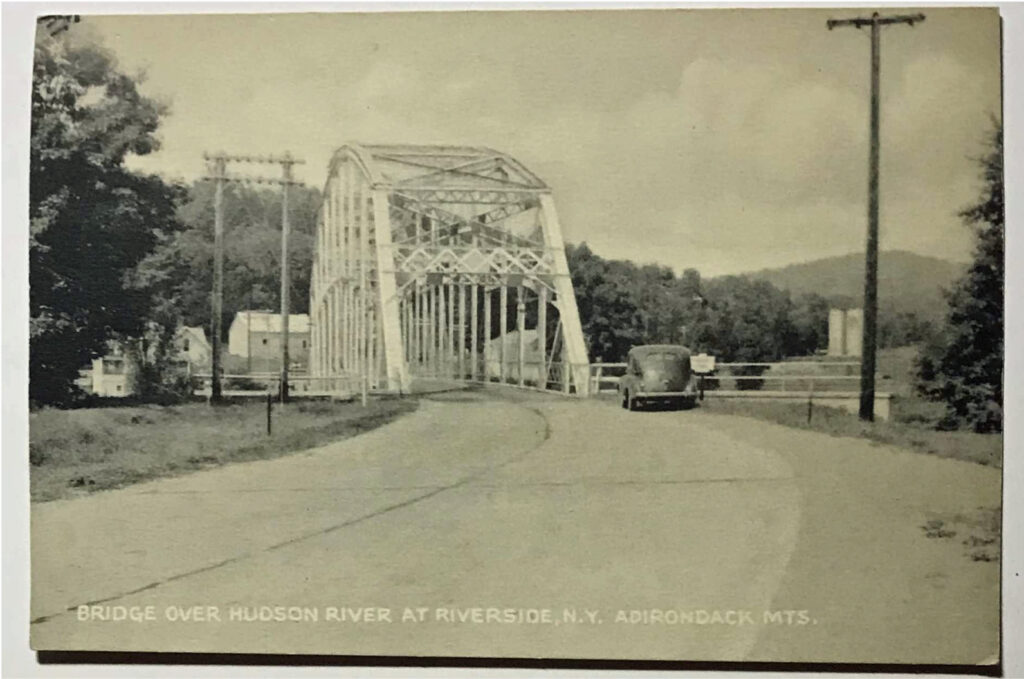
The photograph below was taken by Evelyn Griffis in 1920 while standing the middle of the the 1911 steel bridge of the southward view of the Hudson River.
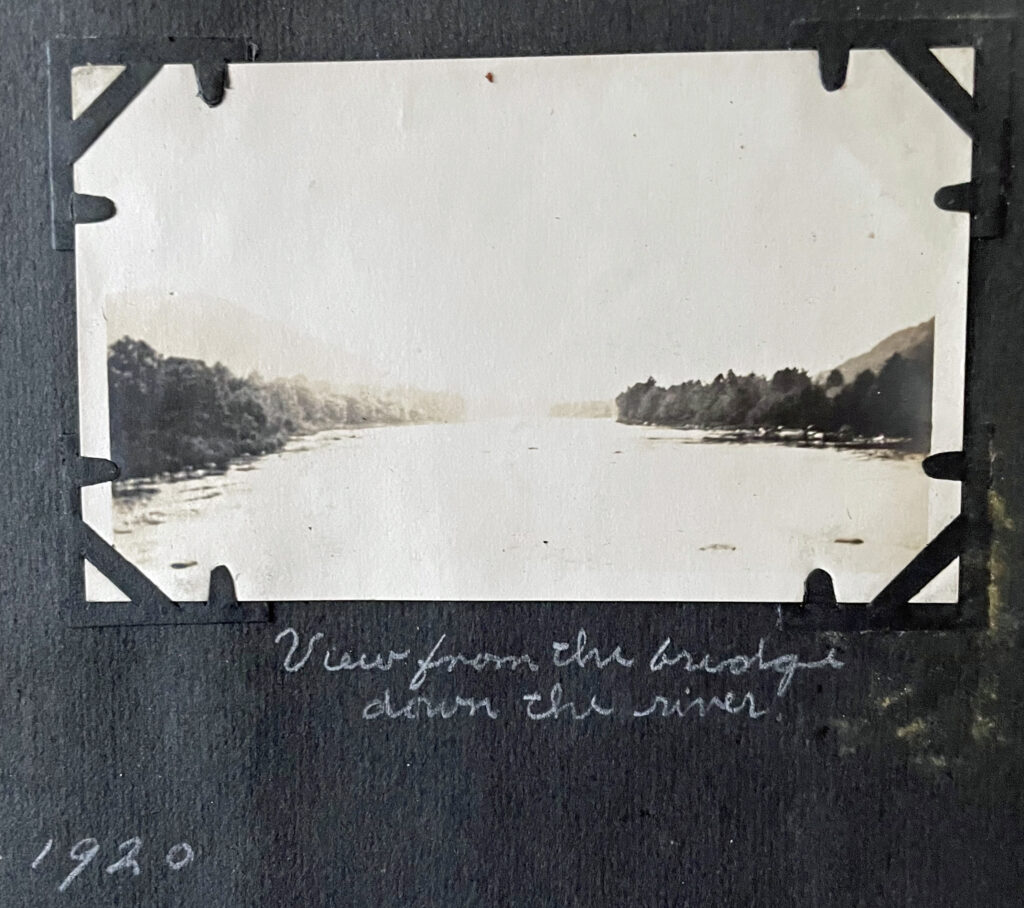
The following photograph of the same view that Evelyn viewed but one hundred years later. It was taken in September 2021 on the current steel bridge, looking southward down the Hudson River. The river does not change much over 100 years.
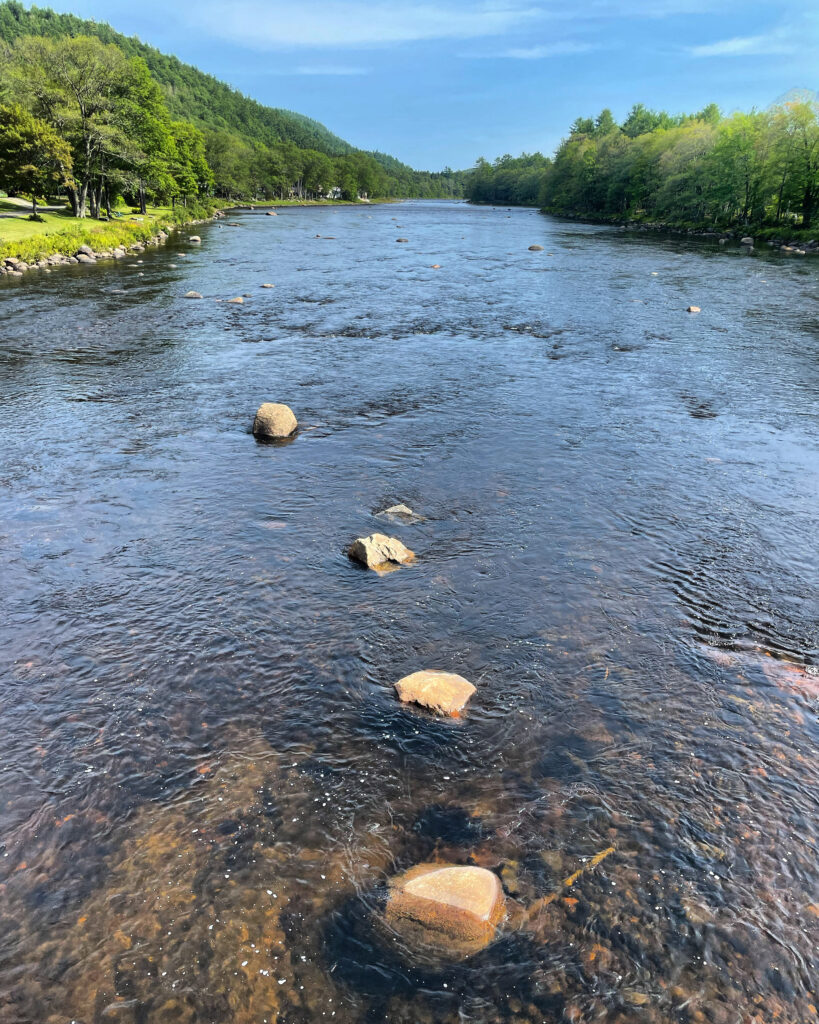
Below is a contemporary view of passing over the Hudson River in Riparius looking south. I was on my mountain bike, traveling westward on Route 8. Leaving the road from the Riverside Camp, I took a left turn westward onto the 2003 Riparius Bridge at the end of a summer’s day.
The following is a contemporary view of the Hudson River while viewing downward into the water from the Riparius bridge. The Hudson River, like all rivers, is perceptually timeless yet with the constant movement of water over rocks that have not moved through generations. It has a permanence that is both fluid and dynamic. Each generation experiences the multi-sensory experiences of this river (the sounds at night of the water, the views of watering over rocks in daylight). Views of the river captured in photographs throughout time are very similar, the building and people in those photographs however change. .
Riverside and Logging
Through most of the 1800°s and into the early 1900’s, the timber and wood-using industries flourished with the expansion and development of other industries in the state of New York. So much white pine lumber was cut that eventually the supply of this species was depleted. Other softwood timber was cut in large volumes and floated down rivers to supply an expanding pulp and paper industry as well as the growing lumber industry. The introduction of steam-driven equipment increased productivity in the woods and at portable sawmills.. Steam-powered trains hauled logs and lumber to market, Both lumber and pulpwood production peaked in the early 1900’s and lumber production changed from softwood to hardwood.
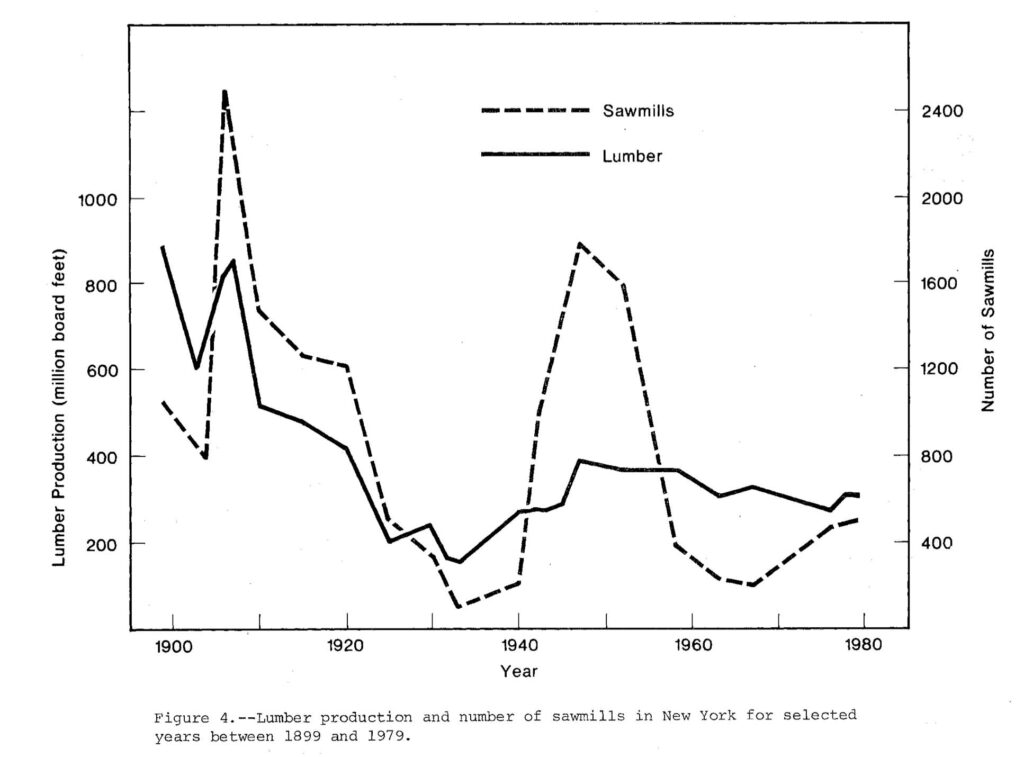
In the upper Hudson, ‘river drives’, moving individual logs down the Hudson River, remained the main mode of log transportation in the upper New York State logging industry until 1950. The last river drive took place January 1950. Over the years timber became more scarce, consequently the losses associated with timber drives were no longer acceptable. They were replaced by tractors and railroads. [45]
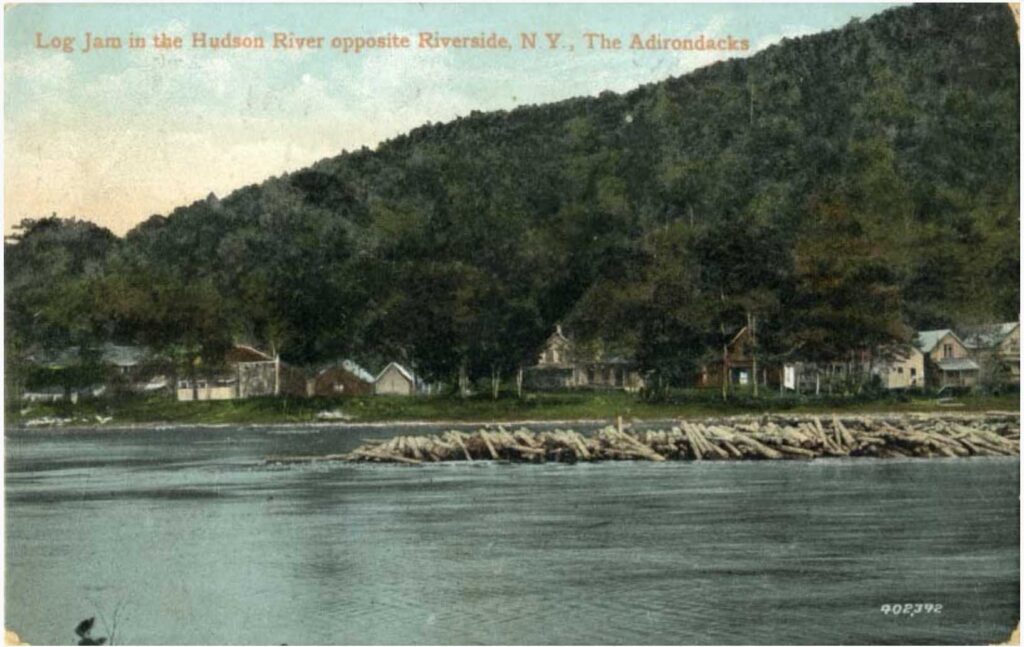
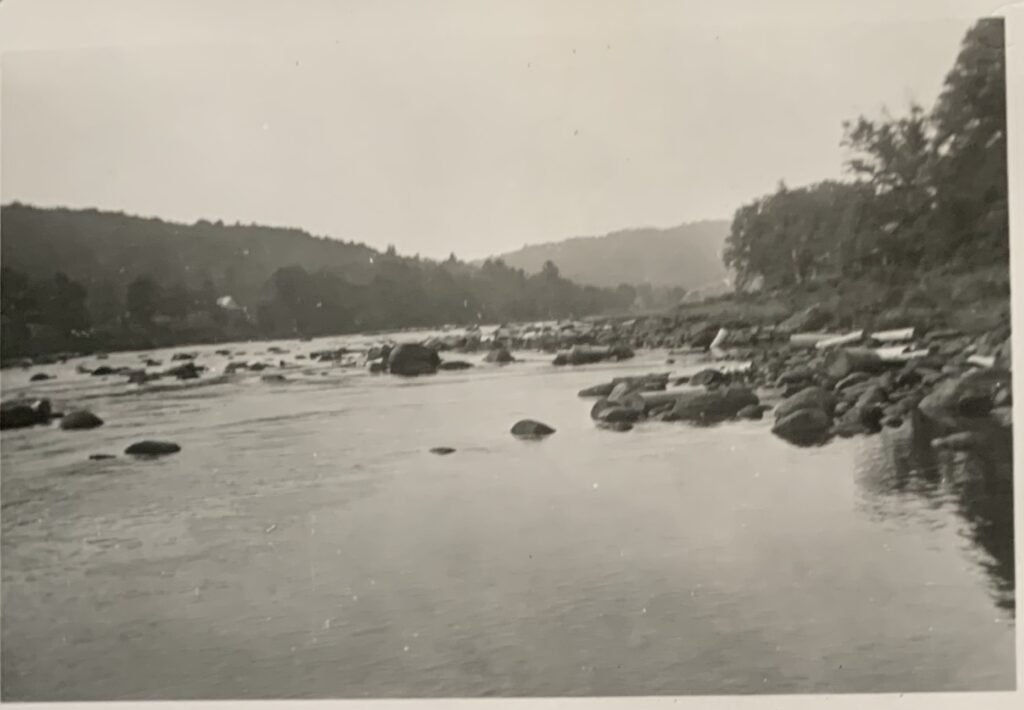
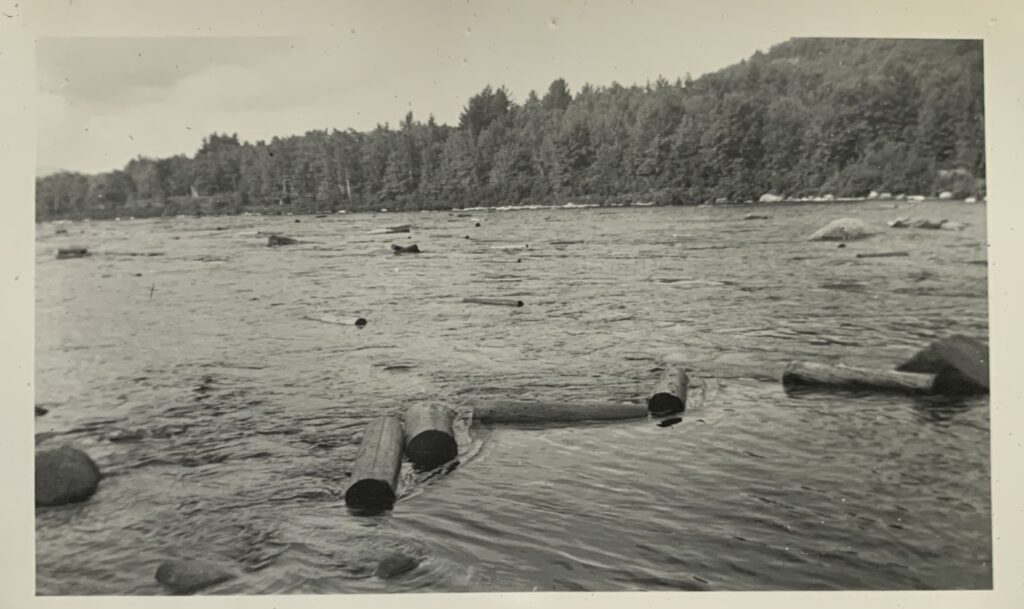
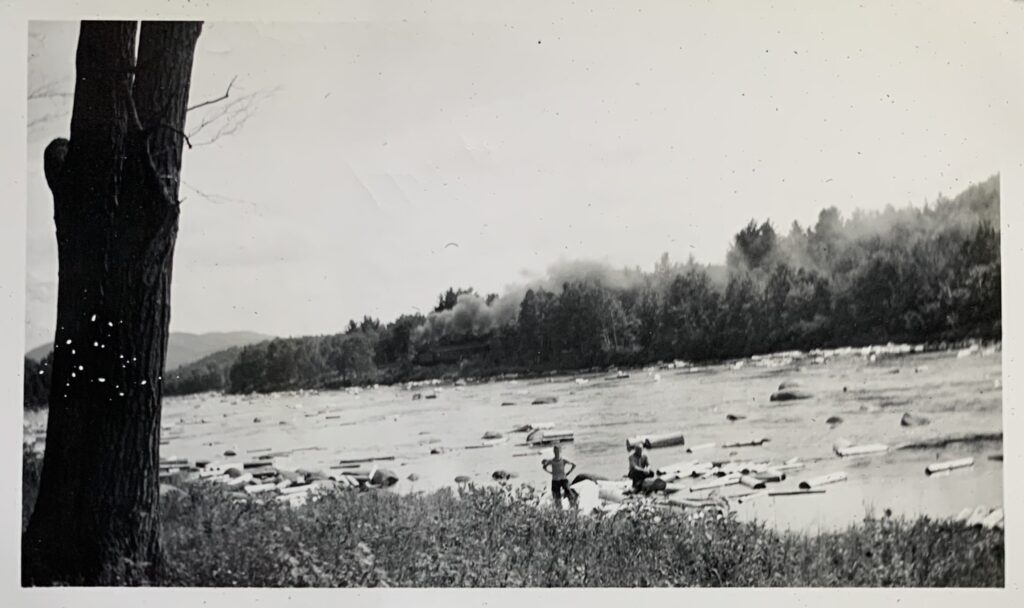


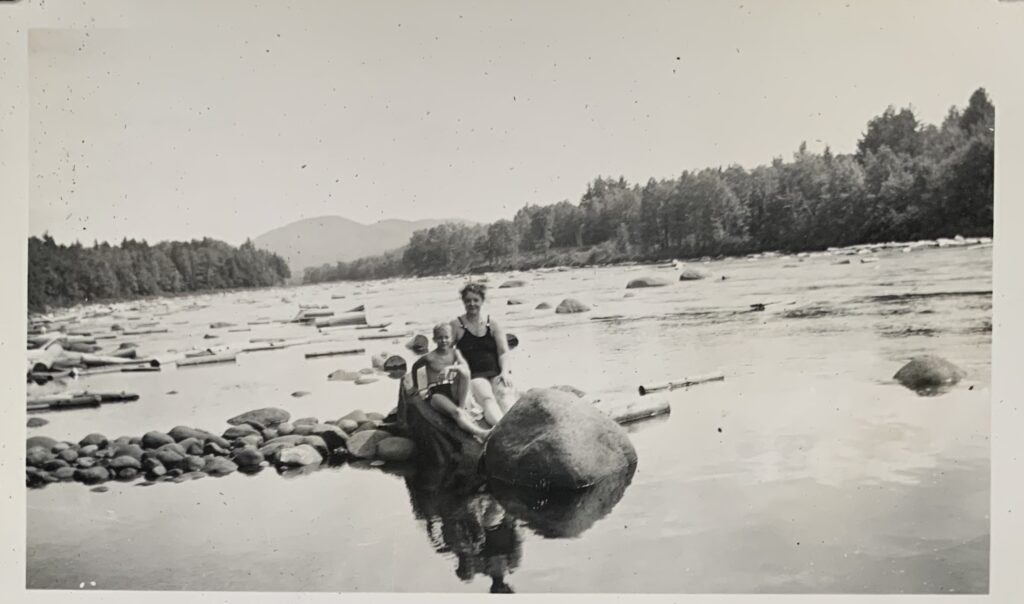
Sources
Featured Image of this Story: The top image shown on this story is a photograph I took in 2019 on Riverside Station Road looking eastward at portions of the the Riverside Camp. Riverside Station Road runs parallel to the Hudson River on the western banks. Click for larger view of the photograph.
In addition to the personal scrapbooks of Evelyn T. Griffis, her daughter Nancy Griffis has been instrumental in obtaining historical material to help put this story together.
[1] Smith, H. P., History of Warren County, with illustrations and biographical sketches of some of its prominent men and pioneers, Syracuse: D. Mason & Co., Publishers, 1885
[2] Smith, Philip, compiled by, Riverside Campground, Self Published 1999
[3] Riparius, Wiktionary, Page last edited on 25 Sep 2019, Page accessed 10 Aug 2021.
[4] Smith, Philip, compiled by, Riverside Campground, Self Published 1999
[5] Warren County, New York , 1938-1962 Grantor Book, Section L, Page 17 Line 29; Adelbert and Susan Lennon deeding property to Harold Griffis, 1942, Warren County New York Clerk On-Line Records
[6] Land Deed, Warren County, New York, Adelbert and Susan Lennon deeding property to Harold Griffis, 1942, Warren County New York Clerk On-Line Records
[7] Warren County, New York, 1938-1962 Grantor Book, Section G, Page33, Harold Griffis modified the deed in 1947 to include Evelyn’s name; and in 1949 sold the cabin to Edith Ford. Warren County New York Clerk On-Line Records
[8] Land Deed, Warrant County, New York, Harold and Evelyn Griffis deeding property to Edith Ford, 1949 Warren County New York Clerk On-Line Records
[9] Warranty Deed between Edith E. Ford and Evelyn T. Griffis, Warren County, New York, June 25, 1973. Warren County New York Clerk On-Line Records
[10] Indentured Land Deed, Warren County, New York, Estate of Milo Knapp deeding property to Herbert Stanley, February 2, 1906 Warren County New York Clerk On-Line Records
[11] Chain (Unit), Wikipedia, Page last updated 26 August 2021, page accessed 12 Sep 2021.
[12] Land Indenture Deed, Warren County, New York , Land transferred from Stanley to Silvernail, October 12, 1920, Warren County New York Clerk On-Line Records
[13] Homer Burtis Silvernail, Obituary, The Times Record, Troy, New York, 16 May 1962, see copy of obituary.
[14] Land Indenture Deed, Warrant County, New York, Land transferred from Bertha Stanley to Homer Silvernail, June 27, 1922, Warren County New York Clerk On-Line Records
[15] Albert J Silvernail, Find a Grave, Born 14 Aug 1905, Halfoon, Saratoga County, NY, Death 18 Mar 2005 (age 99), Vermont, Buriel: Garfield cemetery, Stephentown, Rensselaer County, NY, Memorial ID 331665845, View Source
[16] Land Indenture Deed, Warrant County, New York, Conveyance of property from Silvernail to Lennon, See also Warren County, New York, Grantee Index of Deeds commencing 1931 Warren County New York Page 220 line 25; Adelbert J. Lennon purchasing cottage from Moses B. Silvernail in 1934. See also Warren County NY Grantor Index of Deeds commencing 1931 page 343, Warren County New York Clerk On-Line Records
[17] Important Places, The First Hundred Years, Warren County 200 2013 Bicentennial Celebration, page accessed 21 Aug 2021
[18] Patton, Jon, Overall History of the Adirondack Branch, The Adirondack Branch of the Delaware & Hudson Railroad, Page accessed 20 Aug, 2021
[19] Patton, Jon, Riverside Station Area History, The Adirondack Branch of the Delaware & Hudson Railroad, Page accessed 20 Aug, 2021
[20] Patton, Jon, Riverside Methodist Episcopal Church – c.1900, The Adirondack Branch of the Delaware & Hudson Railroad, Page accessed 20 Aug, 2021
[21] Bond, Hallie, Adirondack Traditions: Spruce Beer?, Adirondack Almanack, February 21, 2013, page accessed 10 Sep 2021
[22] The Post-Star, Glens Falls, New York Tuesday July 16, 1889, Page 3 https://www.newspapers.com/image/420748070/
[23] Patton, Jon, Riverside Hotel, The Adirondack Branch of the Delaware & Hudson Railroad, Page accessed 20 Aug, 2021
[24] Patton, Jon, Riverside Hotel, The Adirondack Branch of the Delaware & Hudson Railroad, Page accessed 20 Aug, 2021
[25] Important Places, The First Hundred Years, Warren County 200 2013 Bicentennial Celebration, page accessed 21 Aug 2021
[26] Camp Meeting, Wikipedia, Page last updated 20 June 2021, Page accessed 10 Sep 2021.
Harmon, Nolan, General Editor, Camp Meetings Encyclopedia of World Methodism, Vol I, 1974 p 384 http://archive.org/details/encyclopediaofwo01harm/page/384/mode/1up?view=theater
Timothy N. Osment, Camp Meetings, Digital, August 2010, Heritage.org camp-meetings Page accessed 23 Sep 2021, https://digitalheritage.org/2010/08/camp-meetings/
[27] The Great Awakening, Wikipedia, Page updated 1 Oct 2021, Page accessed 1 oct 2021.
The Great Awakening refers to various periods of religious revival in American Christian history. Historians and theologians identify three or sometimes four waves of increased religious enthusiasm between the early 18th century and the late 20th century. The First Great Awakening began in the 1730s and lasted to about 1740. The Second Great Awakening, also simply known as “the Great Awakening”, was a religious revival that occurred in the United States beginning in the late eighteenth century and lasted until the middle of the nineteenth century. While it occurred in all parts of the United States, it was especially strong in the Northeast and the Midwest. The Third Great Awakening generally occurred in the 1850s–1900s was characterized by new denominations, active missionary work, Chautauquas, and the Social Gospel approach to social issues.
Others have defined the third awakening as being between 1855-1930, See for example, Anrtonia Ćirjak, World Atlas, When was the third Awakening. https://www.worldatlas.com/articles/when-was-the-third-great-awakening.html , June 1 2020, page accessed 23 Sep 2021; also The Third Great Awakening, http://oer2go.org/mods/en-boundless/www.boundless.com/u-s-history/definition/third-great-awakening/index.html , Page accessed 23 Sep 2021; See also: Fogel, Robert W., The Fourth Great Awakening & the Future of Eqalitarianism, Chicago: University of Chicago Press, 2000.
[28] Lovino, Joe, “Fishing with a large net”: UM camp meetings, United Methodist Church, Sep 5, 2018 https://www.umc.org/en/content/fishing-with-a-large-net-united-methodist-camp-meetings
[29] Nancy Ferguson and Jennifer Burch, Religious Camps: Common Roots and New Spouts, 2011 November/December Camping Magazine, internet version: https://www.acacamps.org/resource-library/camping-magazine/religious-camps-common-roots-new-sprouts
[30] New World Encyclopedia contributors, “Camp meeting,” New World Encyclopedia, , https://www.newworldencyclopedia.org/p/index.php?title=Camp_meeting&oldid=1002562 (accessed September 23, 2021).
For additional references see the following:
- Allen, David. The Mow Cop Revival, 1807. Stoke-on-Trent: Tentmaker Publications, 2007. ISBN 9781901670387.
- Brown, Kenneth O. Holy Ground: A Study of the American Camp Meeting. Garland reference library of social science, v. 717. New York: Garland, 1992. ISBN 9780824048372.
- Bruce, Dickson D. And They All Sang Hallelujah; Plain-Folk Camp-Meeting Religion, 1800-1845. Knoxville: University of Tennessee Press, 1974. ISBN 9780870491573.
- Chapman, J. B. Camp Meeting Sermons. Kansas City, Mo.: Nazarene Pub. House, 1935. OCLC 8021880
- Eslinger, Ellen. Citizens of Zion: The Social Origins of Camp Meeting Revivalism. Knoxville: University of Tennessee Press, 1999. ISBN 9781572330337.
- Fankhauser, Craig Charles, and John Lyscom. Christian Holiness, Methodism, and Camp Meeting Revival in Pre-20th Century America. Independence, Kan: Holiness Advocate Pub, 2001. OCLC 49541503.
- Johnson, William Courtland. To Dance in the Ring of All Creation: Camp Meeting Revivalism and the Color Line, 1799-1825. Thesis (Ph.D.)—University of California, Riverside, 1997. OCLC 38136388.
- Lander, John K. Itinerant Temples: Tent Methodism, 1814-1832. Studies in evangelical history and thought. Waynesboro, GA: Paternoster Press, 2003. ISBN 9781842271513.
- Pell, William E. The Southern Zion’s Songster Hymns Designed for Sabbath Schools, Prayer, and Social Meetings, and the Camps. Chapel Hill, NC: Academic Affairs Library, University of North Carolina at Chapel Hill, 2000. OCLC 45409535.
- Elizabeth Humphrey, Camp Meetings: A Continued Tradition, Material Matters: Winterthur Program in American Material Culture, https://sites.udel.edu/materialmatters/2018/07/25/camp-meetings-a-continued-tradition/
[31] Smith, Philip, compiled by, Riverside Campground, Self Published 1999, Page 10: 26 Aug 1909 Newspaper quote from the Warrensburg News and North Creek News
[32] Smith, H. P., History of Warren County, with illustrations and biographical sketches of some of its prominent men and pioneers, Syracuse: D. Mason & Co., Publishers, 1885, footnote on page 540.
[33] Smith, Philip, compiled by, Riverside Campground, Self Published 1999
[34] Smith, Philip, Riverside Campground, Self Published 1999, pages 4 – 20
[35] Glenn Fish, The Campground, part of a compilation by Smith, Philip, Riverside Campground, Self Published 1999, pages 21 – 26
[36] Johnsburg, New York, Wikipedia, Page updated 16 Dec 2020, Page accessed 20 Sep 2021.
[37] Glenn Fish, The Campground, part of a compilation by Smith, Philip, Riverside Campground, Self Published 1999, Page 21.
[38] Newspaper article from the Glens Falls Republican Newspaper, Glens Falls, NY, 26 Oct 1875.
[39] Glenns Falls Republican newspaper, 25 June 1878
[40] Warrensburg News and North Creek News, 8 Aug 1895
[41] Smith, Philip, Riverside Campground, Self Published 1999, Page 4.
[42] Glenn Fish, The Campground, part of a compilation by Smith, Philip, Riverside Campground, Self Published 1999, Page 22.
[43] Patton, John, Suspension Bridge over Hudson River at Riverside, NY, The Adirondack Branch of the Delaware & Hudson Railroad, Brasshistory.net, page accessed 20 Aug 2021
[44] Suspension Bridge across the Hudson River at Riverside, The Adirondack Mts., N.Y., Object Record on the Adirondack Experience, the Museum of Blue Mountain Lake
[45] Robert L. Nevel, Jr. Everett L. Stochia, Thomas Wahl, New York Timber Industries A Periodic Assessment of Timber Output, Forest Service, U.S. Department of Agriculture, Northeastern Forest Experiment Station, Resource Bulletin NE-73, 1982
Pearsall, Glenn, An Old Hudson River Chain Recalls Logging History, New York Almanack, Jay Heritage center, Page accessed 24 Aug 2021.
[46] Log Jam in the Hudson River opposite Riverside, N.Y., The Adirondacks, Historic Postcard Collection, Adirondack Experience, The Museum on Blue Mountain Lake, Page accessed 24 Aug 2021; See also On the Hudson River near Riverside Camp, Adirondack, N.Y., another post card illustrating a view from Riverside camp looking north toward the bridge with logs in the river.
Mosley, Will, Logging and Timber Production in The Upper Hudson Watershed 1800-1950, Public Timelines, Page accessed 21 Aug 2021


